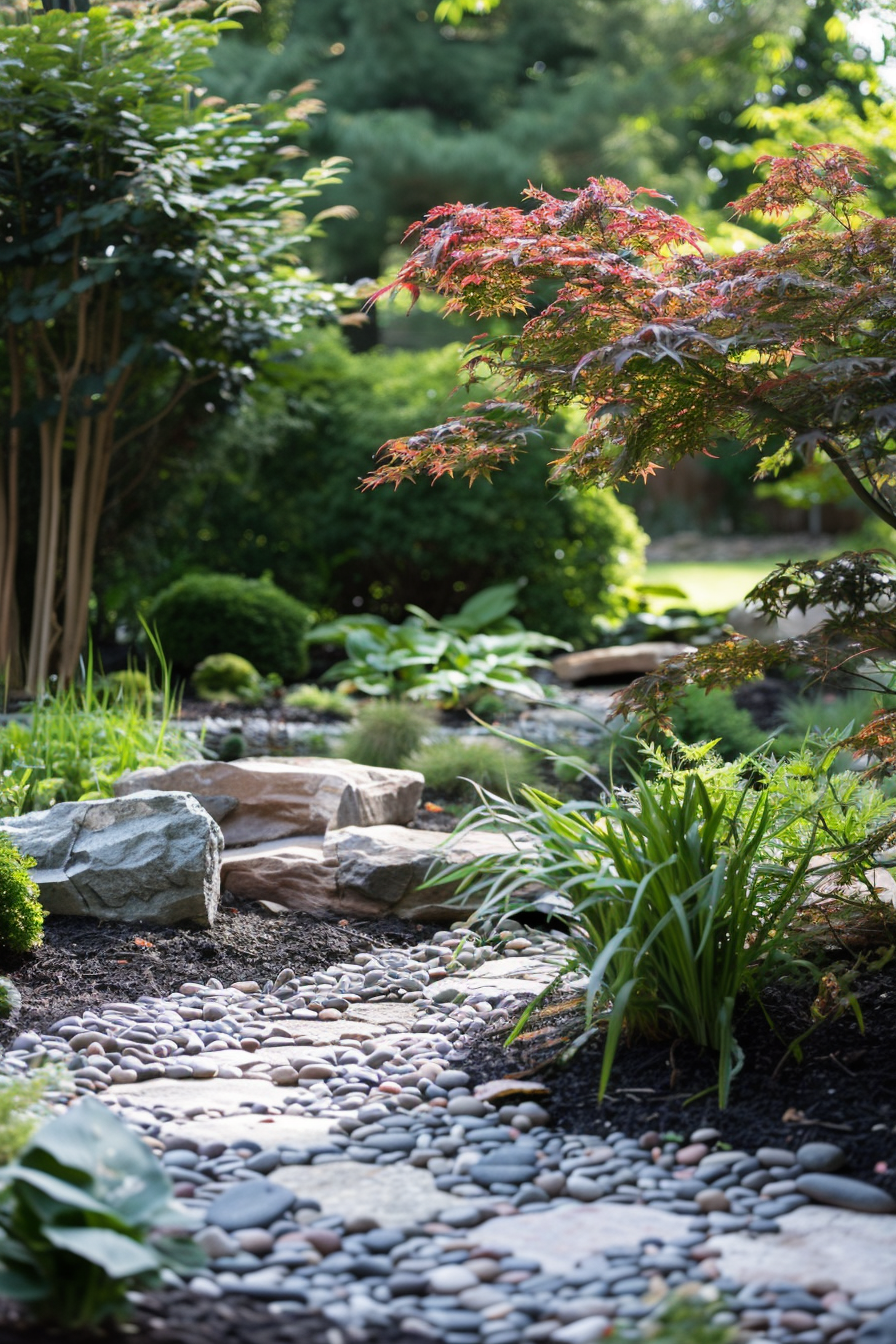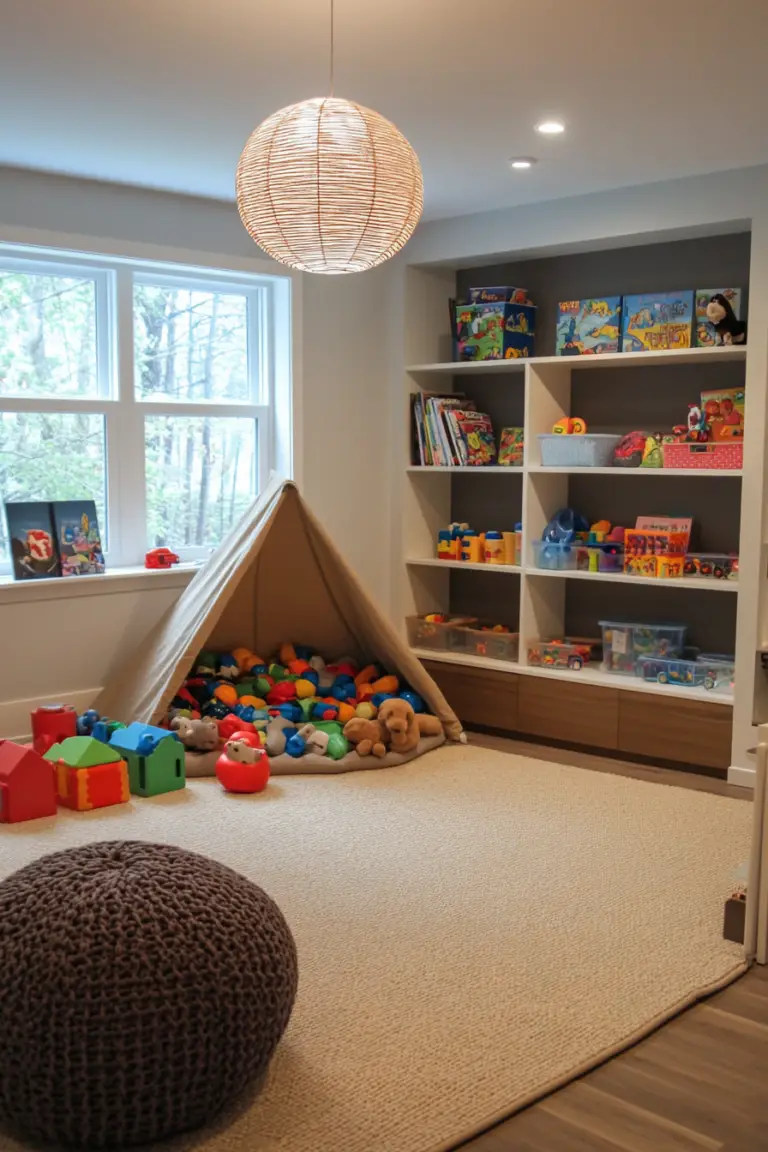The Best Way to Use Rocks in Your Flower Bed
Did you know that adding rocks to your flower bed can create a stunning visual impact while reducing garden maintenance? Rocks aren’t just for rock gardens—they can transform any flower bed into a masterpiece. Let’s dive into how you can use rocks to elevate your garden game.
Rocking Your Flower Bed: The Basics
Using rocks in your flower bed is a fantastic way to add texture, contrast, and a natural vibe to your garden. Whether you’re aiming for a minimalist zen look or a vibrant, rustic feel, rocks can make it happen.
- Texture and Contrast: Rocks come in all shapes, sizes, and colors, allowing you to play with different textures and contrasts against your plants.
- Low Maintenance: They help suppress weeds and retain soil moisture, meaning less work for you (yay!).
- All-Season Appeal: Unlike some plants that only shine part of the year, rocks look great all year round.
Choosing Your Rocks: Size Matters!
When it comes to selecting rocks, consider the overall style you want to achieve.
- Pea Gravel: Perfect for filling in spaces and creating pathways. It’s small, affordable, and easy to spread.
- River Rocks: These smooth, medium-sized stones are great for borders and add a serene, water-washed look.
- Boulders: Want to make a statement? Incorporate a few large boulders as focal points in your flower bed.
(Tip: Mix and match different sizes for a more natural and interesting look.)
Budget-Friendly and DIY Options
Who says you need to break the bank to rock your garden?
- Collect Your Own Stones: If you have access to natural areas, collect stones (just make sure it’s allowed).
- Reuse and Recycle: Use broken concrete pieces or bricks for a rustic charm.
- DIY Rock Painting: Get crafty and paint some of the rocks for pops of color or to label your plants.
How to Personalize Your Flower Beds
Your garden should reflect your personality. Here’s how to add that personal touch:
- Create Patterns: Arrange rocks in spirals, circles, or mosaic patterns for visual interest.
- Add Sculptures or Figurines: Tuck in some garden gnomes or fairy houses among the rocks and flowers.
- Combine with Other Elements: Incorporate driftwood, metal art, or glass ornaments for a diverse texture palette.
(Remember, there are no rules—just let your creativity flow!)
Ready to Rock Your Garden?!
- Plan Before You Plant: Sketch out your design to scale, so you know how many rocks you’ll need.
- Layering is Key: Place larger rocks first, then fill in gaps with smaller stones and gravel.
- Consider the Plants: Choose drought-tolerant plants if you’re using rocks extensively, as rocks can reflect heat.
- Maintenance Check: Install landscape fabric under rocks to prevent them from sinking into the soil and to reduce weeds.
- Safety First: When lifting heavy rocks, remember to lift with your legs, not your back.
1. Create a Natural Rock Border
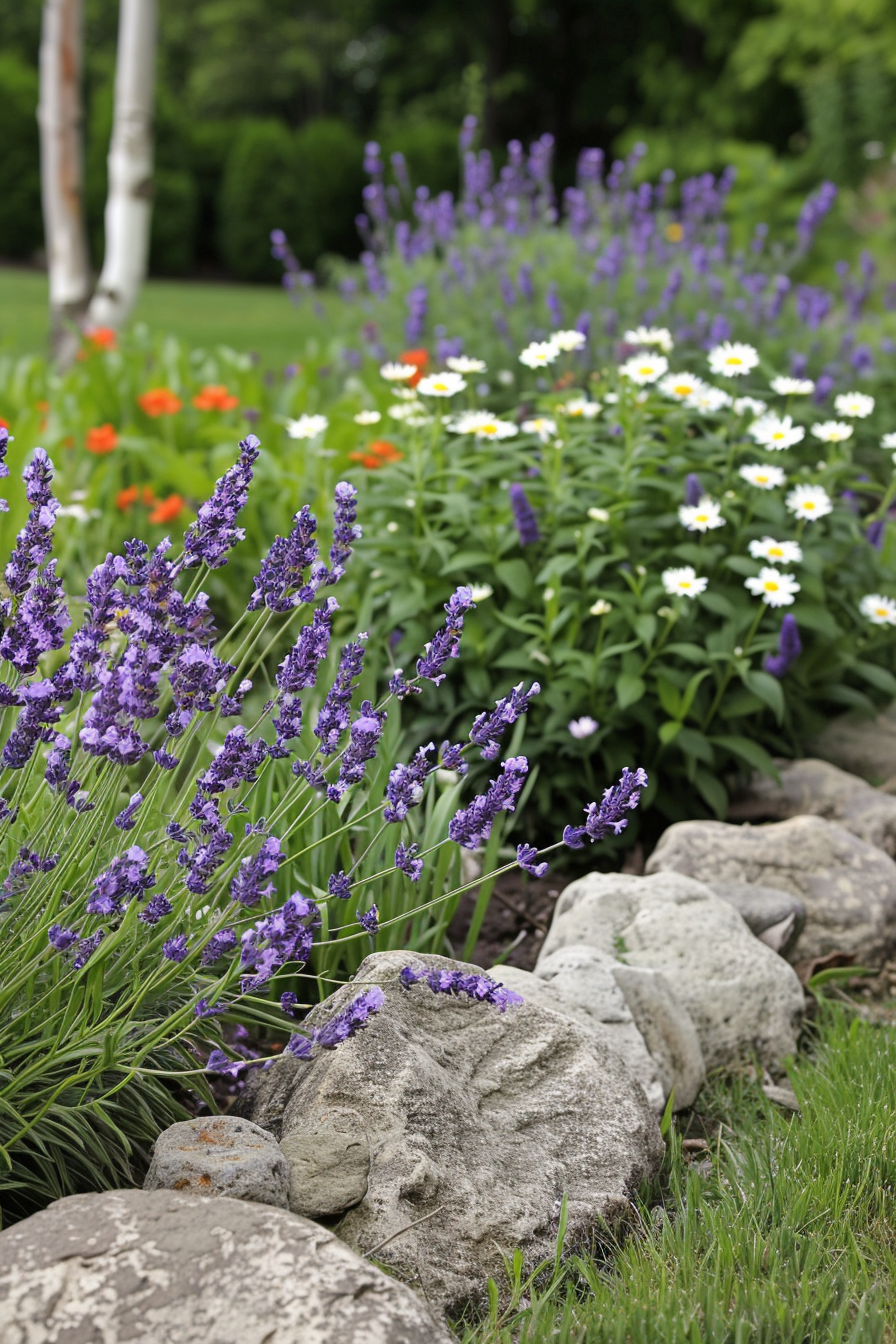
Using rocks to outline your flower bed helps define its shape and gives it a structured look. Choose stones that complement your garden’s color palette and style. Larger rocks can serve as a bold frame, while smaller pebbles can offer a softer boundary.
Flower Suggestions:
- Lavender (Lavandula angustifolia): With its silvery-green foliage and purple flowers, lavender creates a lovely contrast against the earthy tones of rocks.
- Shasta Daisy (Leucanthemum × superbum): The bright white flowers and dark green leaves stand out against rocky borders.
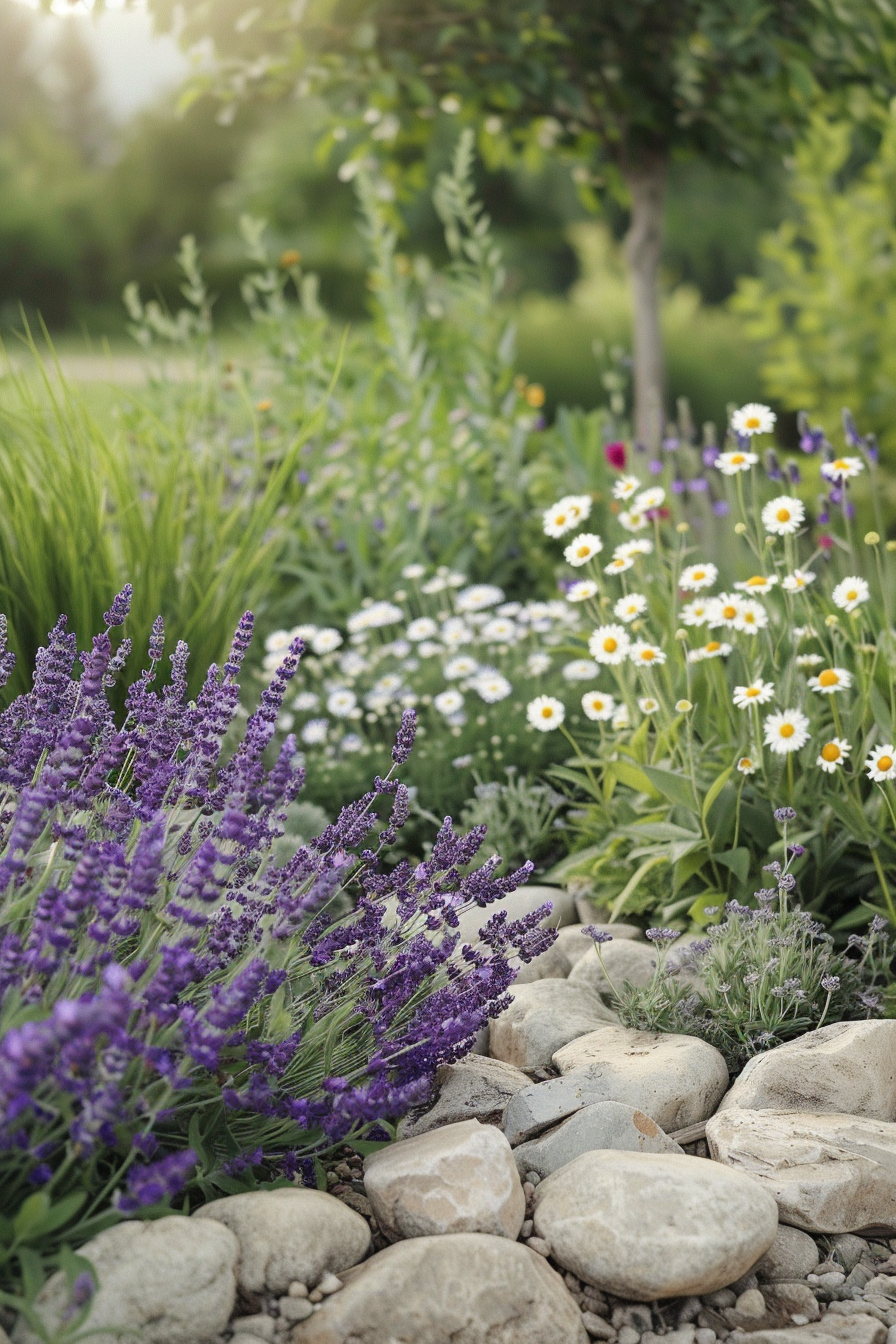
2. Use Rocks as a Mulch Alternative
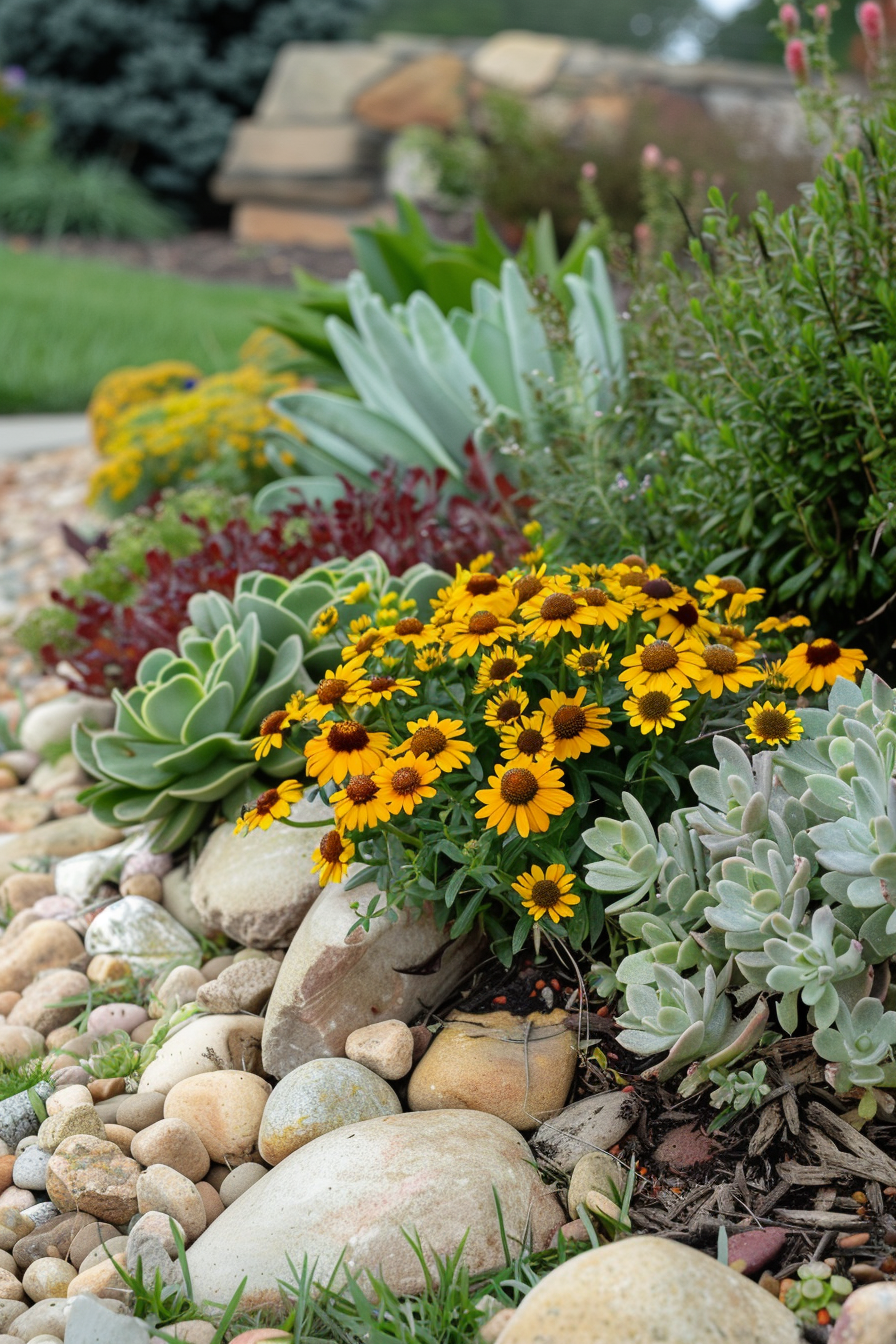
Instead of traditional mulch, use small stones or gravel around your plants. This helps retain soil moisture, reduce weeds, and gives your flower bed a clean, modern look.
Flower Suggestions:
- Sedum (Sedum spp.): These hardy succulents thrive in rocky, well-drained soils and come in various shapes and colors.
- Coreopsis (Coreopsis spp.): With their bright yellow flowers, coreopsis adds a splash of color against the muted tones of gravel.
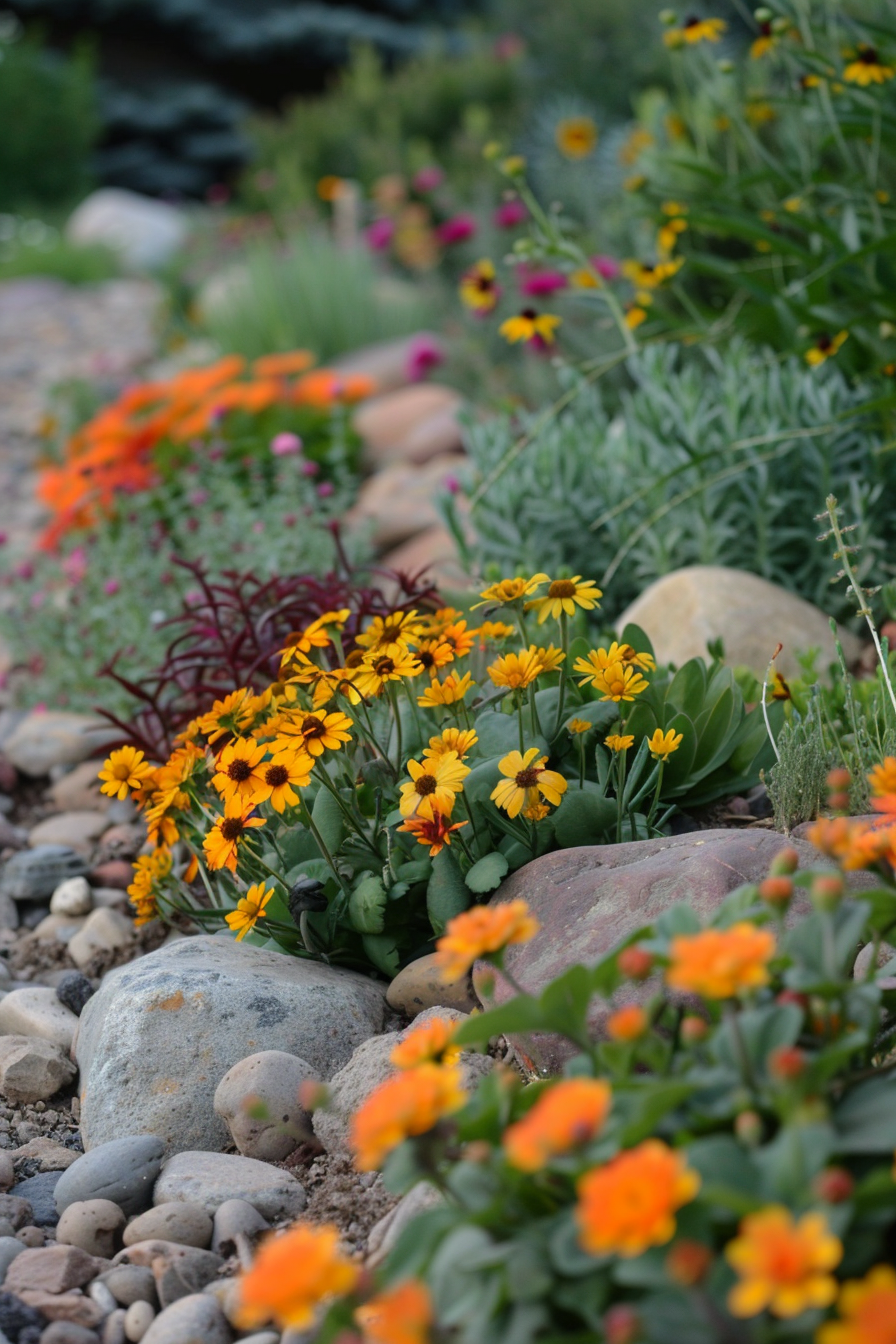
3. Design a Rock Garden
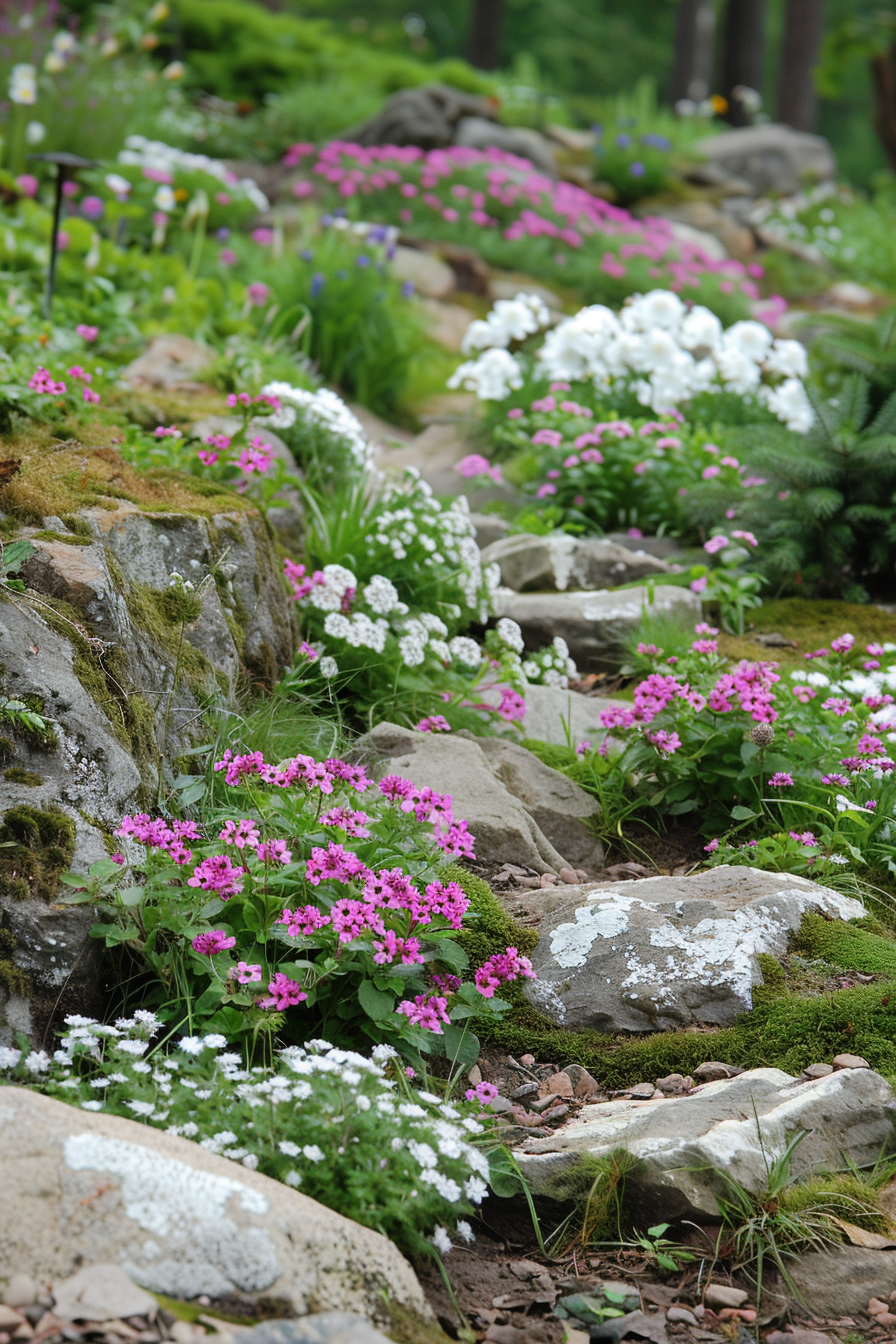
Combine different sizes and types of rocks to create a rock garden within your flower bed. This can add height, texture, and a natural focal point to your landscape.
Flower Suggestions:
- Creeping Thyme (Thymus serpyllum): This low-growing herb with pink flowers is perfect for filling gaps between rocks.
- Rock Cress (Arabis spp.): Known for its cascading white or purple flowers, rock cress thrives in rocky environments.
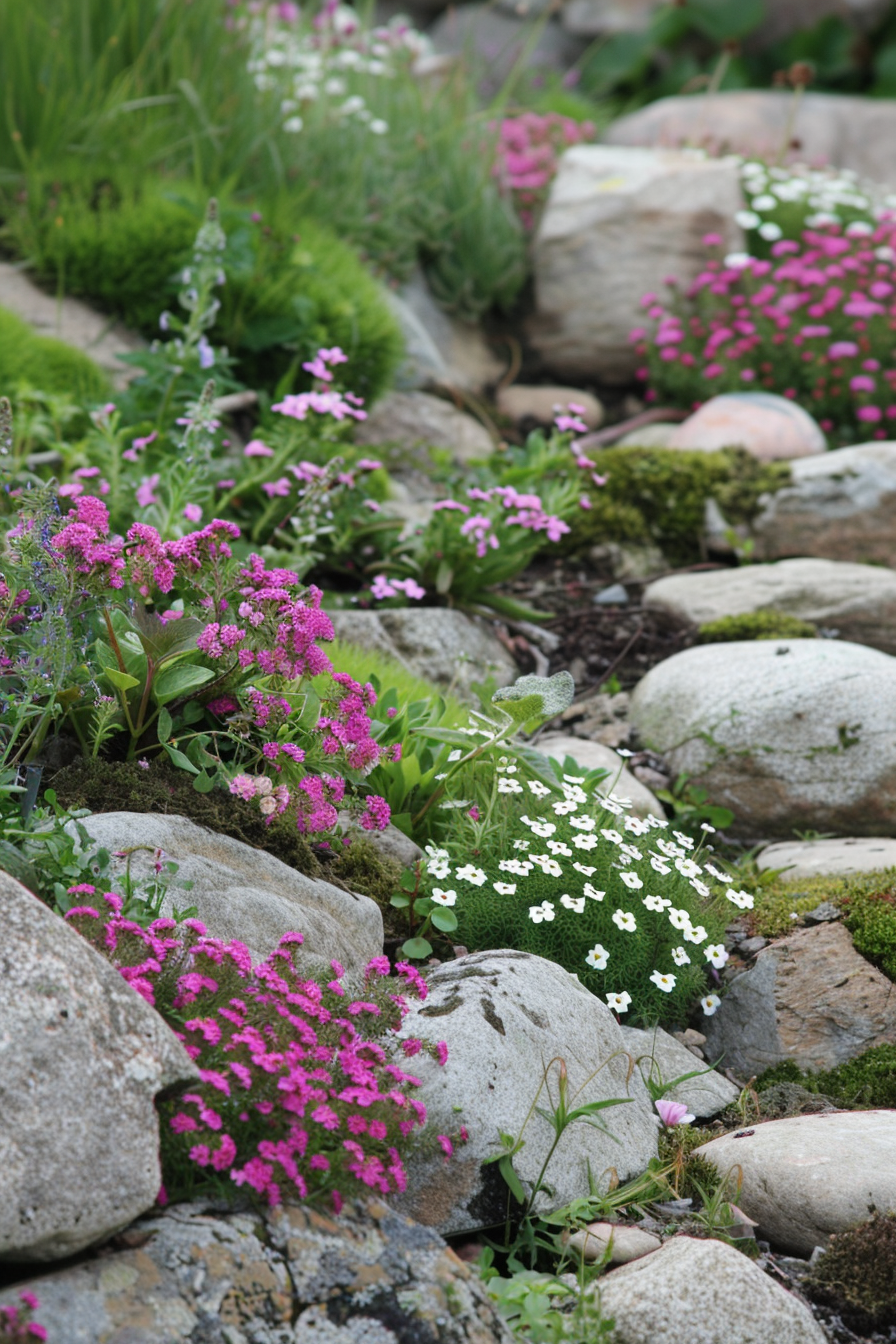
4. Build a Rock Pathway
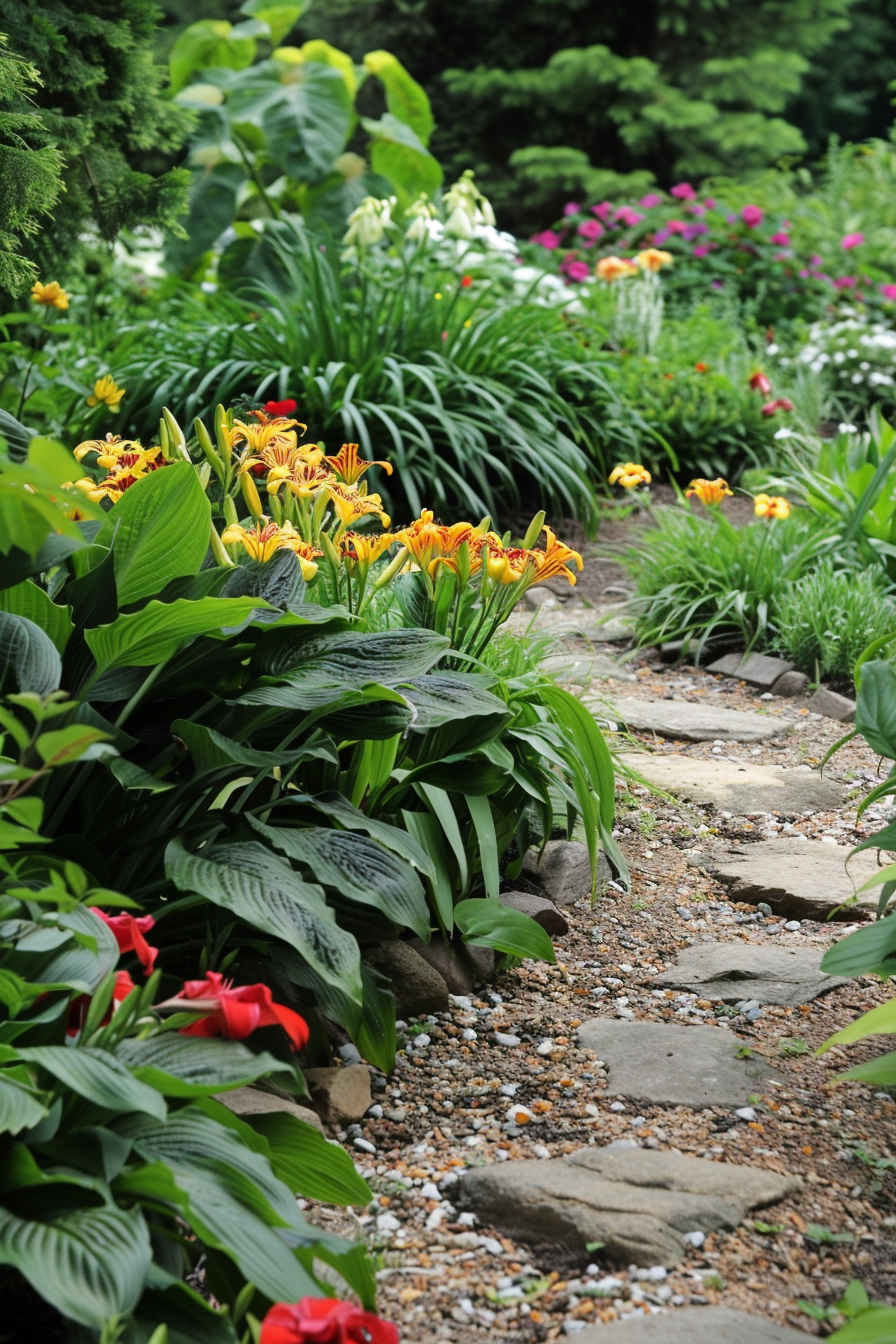
A pathway made of stepping stones or gravel can lead through your flower bed, making it accessible and adding a structured element to your garden design.
Flower Suggestions:
- Hosta (Hosta spp.): With its lush, large leaves, hosta adds a touch of elegance along pathways.
- Daylilies (Hemerocallis spp.): These vibrant flowers bloom in a variety of colors and line paths beautifully.
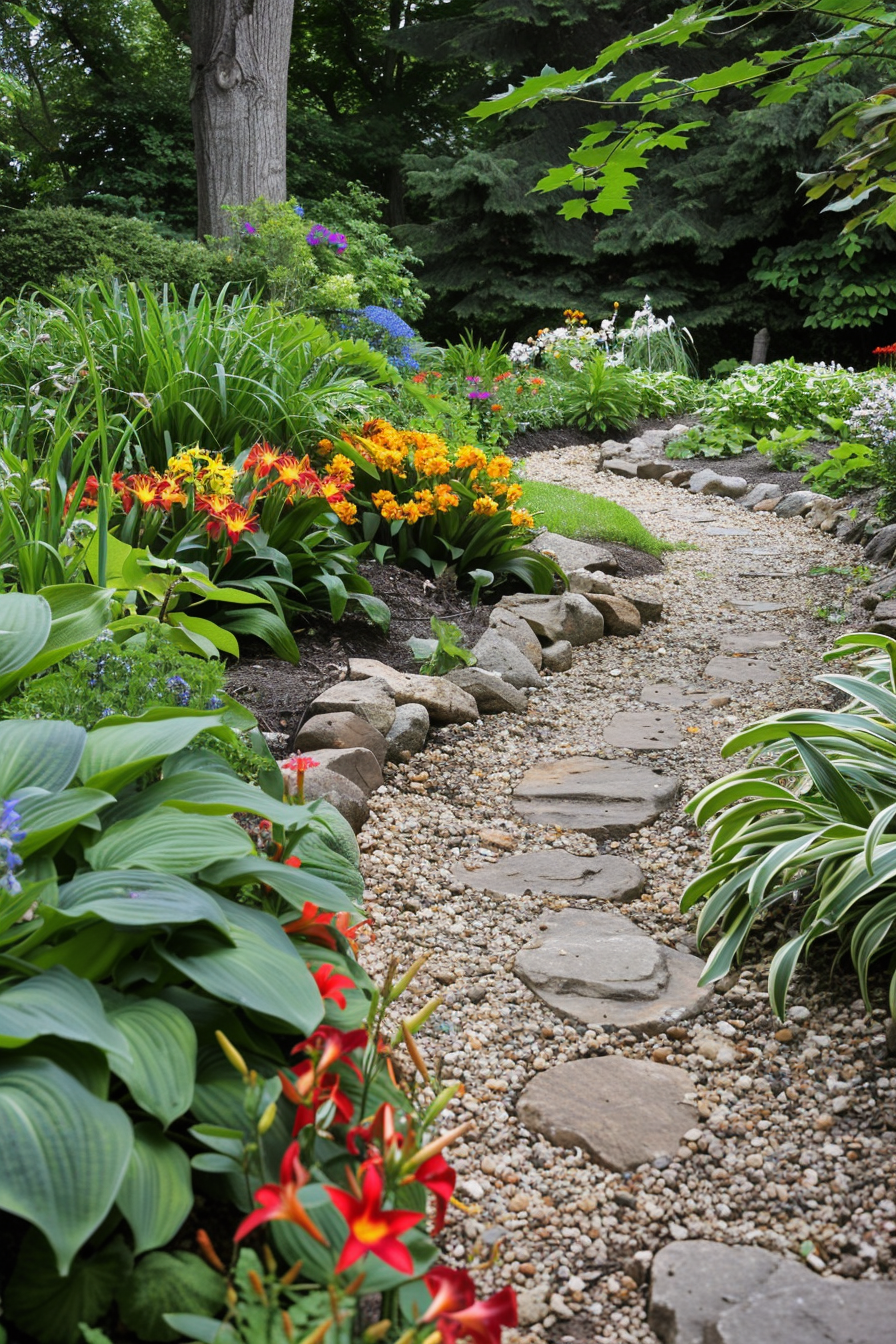
5. Integrate Rocks as Planting Pockets
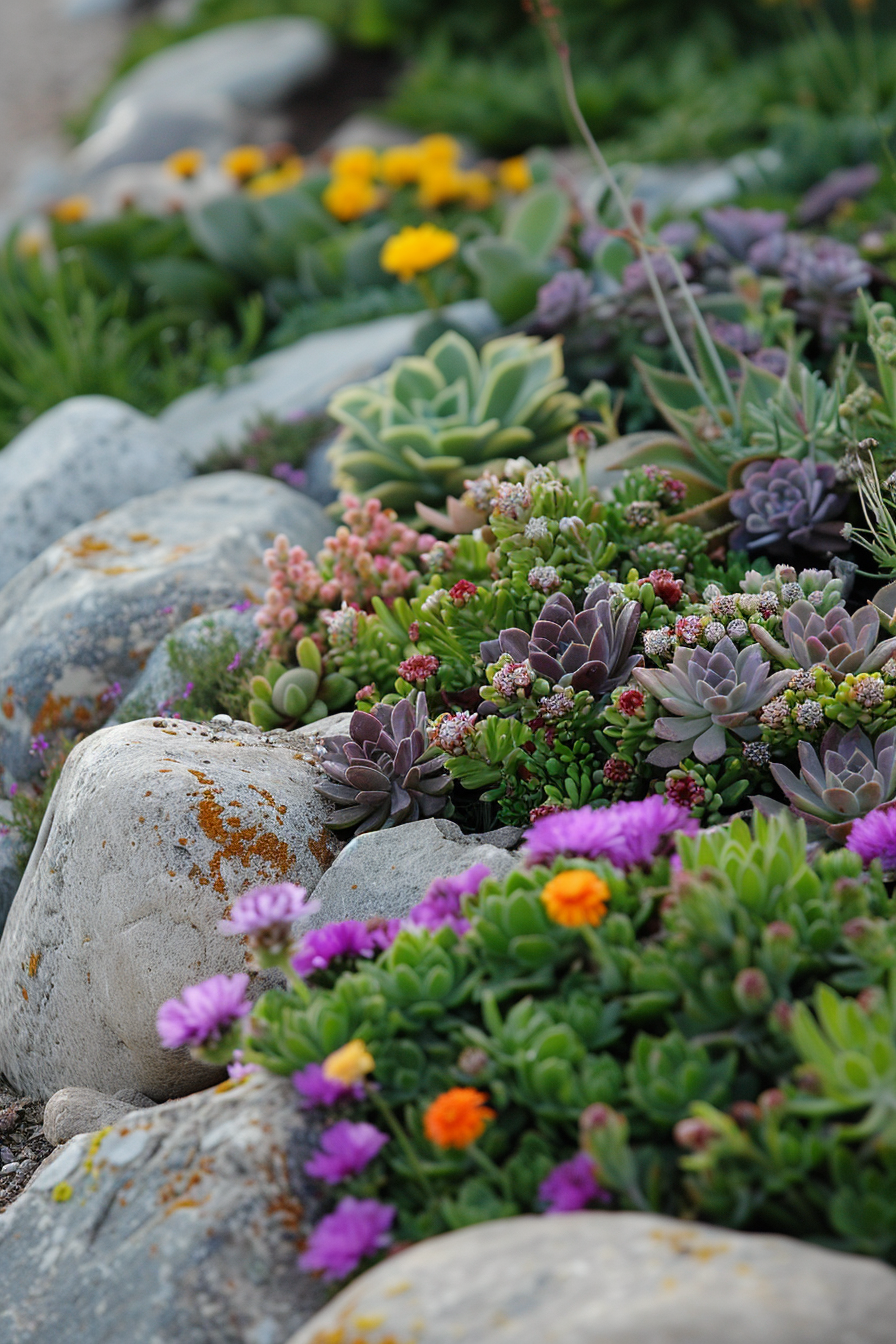
Use rocks to create small pockets of soil within your flower bed. These pockets are ideal for growing plants that thrive in rocky, well-drained conditions.
Flower Suggestions:
- Succulents (Various species): These drought-tolerant plants, like Echeveria and Sempervivum, are perfect for rocky pockets.
- Alpine Aster (Aster alpinus): This hardy, low-growing aster with purple flowers fits well into small rock pockets.
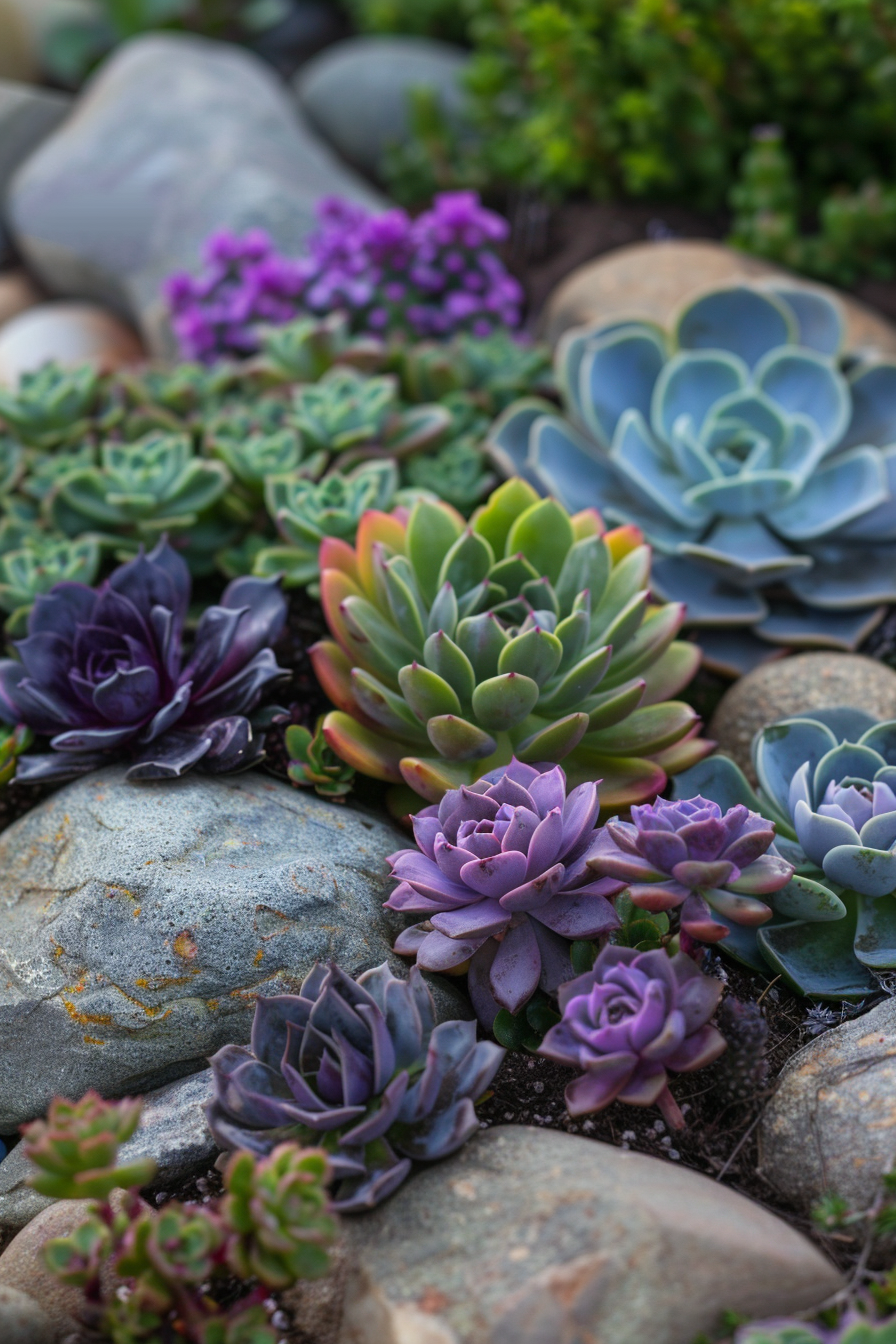
6. Use Boulder Accents
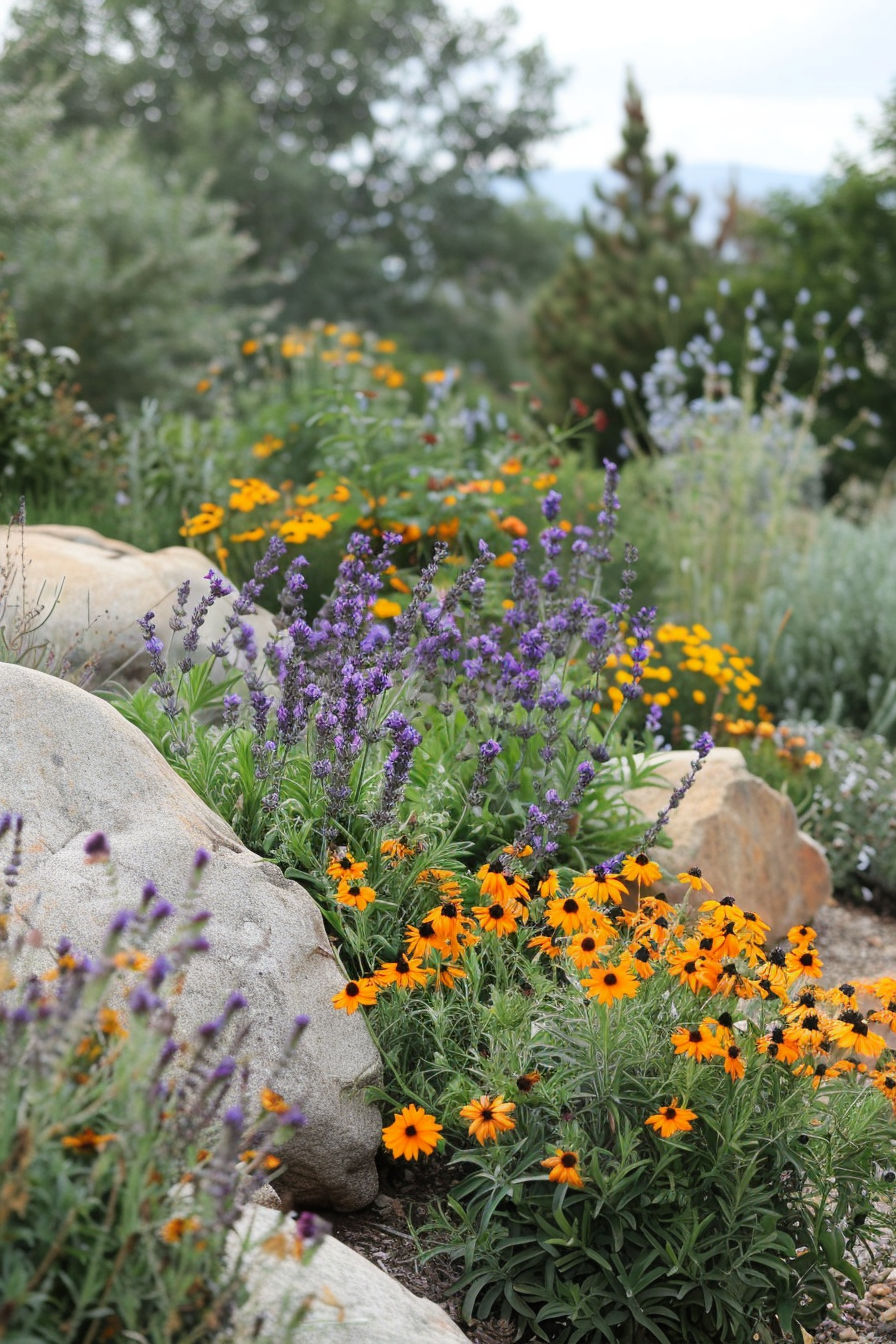
Large boulders can serve as striking focal points in your flower bed. Position them strategically to draw the eye and add a sense of permanence to your garden.
Flower Suggestions:
- Russian Sage (Perovskia atriplicifolia): The airy, lavender-blue flowers of Russian sage create a beautiful contrast against large boulders.
- Black-eyed Susan (Rudbeckia hirta): These bright yellow flowers pop against the backdrop of dark, rugged stones.
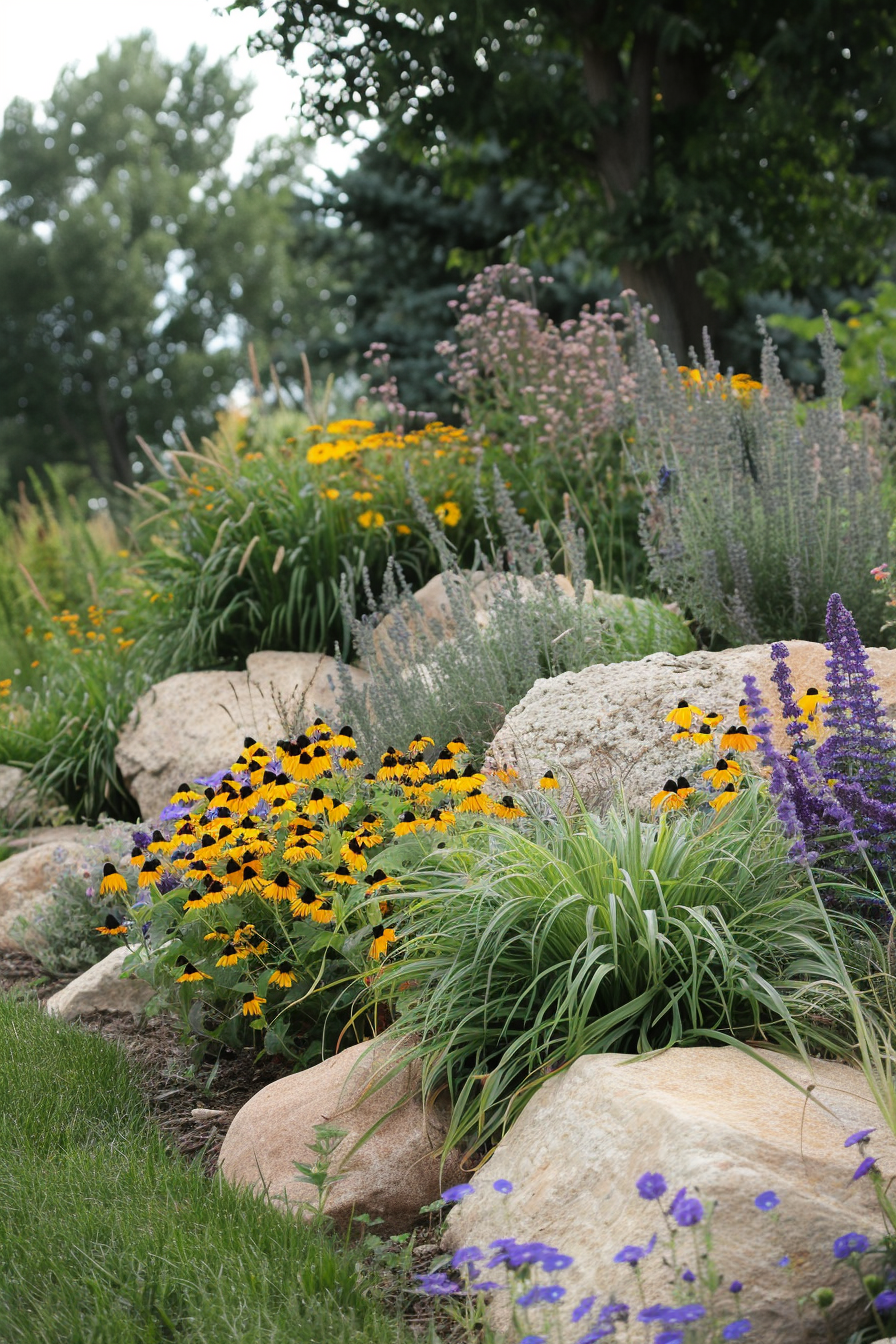
7. Create a Dry River Bed
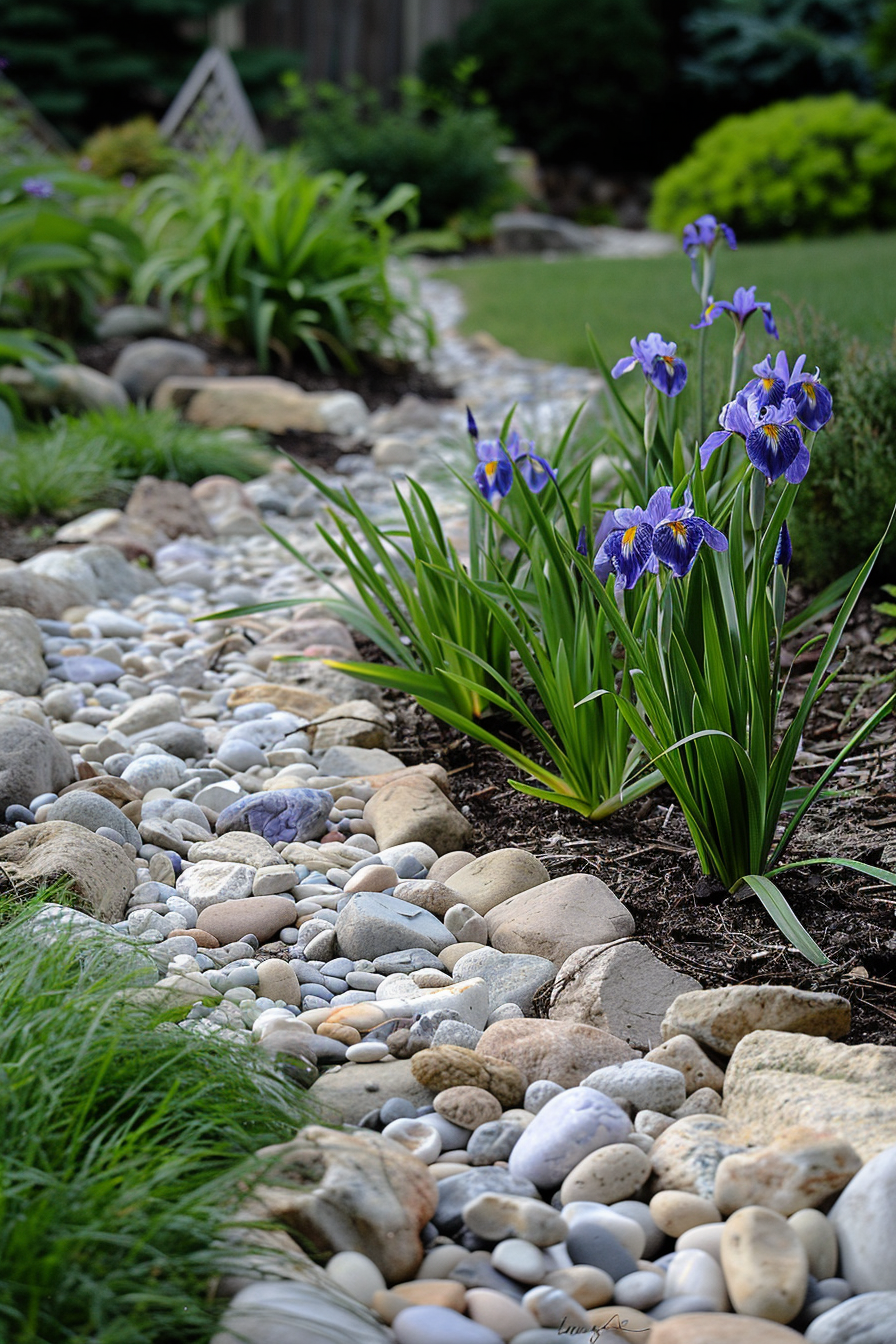
Simulate a dry stream with a variety of rocks and pebbles to add a unique, natural feature to your flower bed. This can also help with drainage and prevent erosion.
Flower Suggestions:
- Blue Fescue (Festuca glauca): This ornamental grass with blue-grey foliage mimics the flow of water along a dry river bed.
- Japanese Iris (Iris ensata): The tall, graceful flowers of Japanese iris add height and color to the dry bed design.
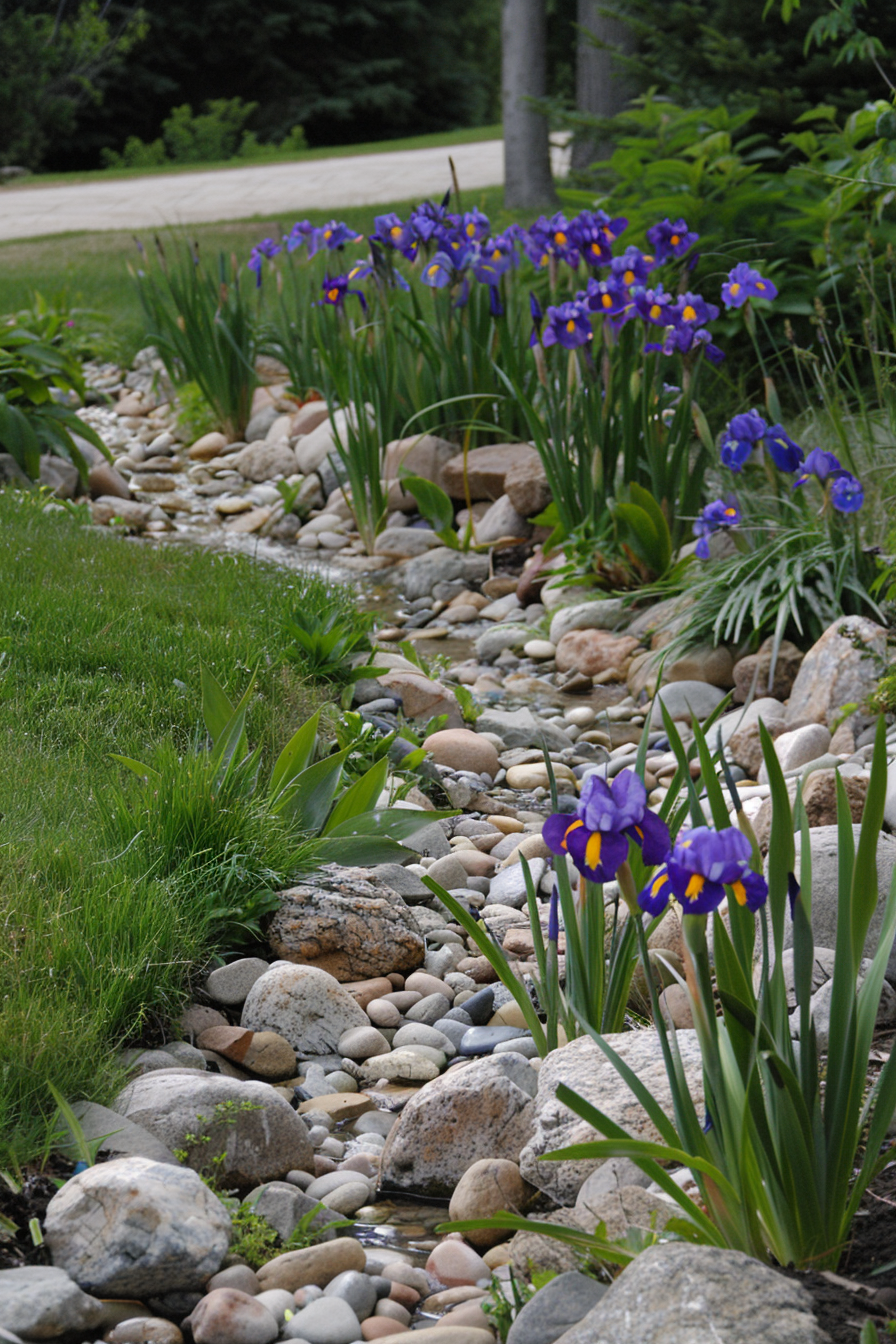
8. Combine Rocks with Water Features
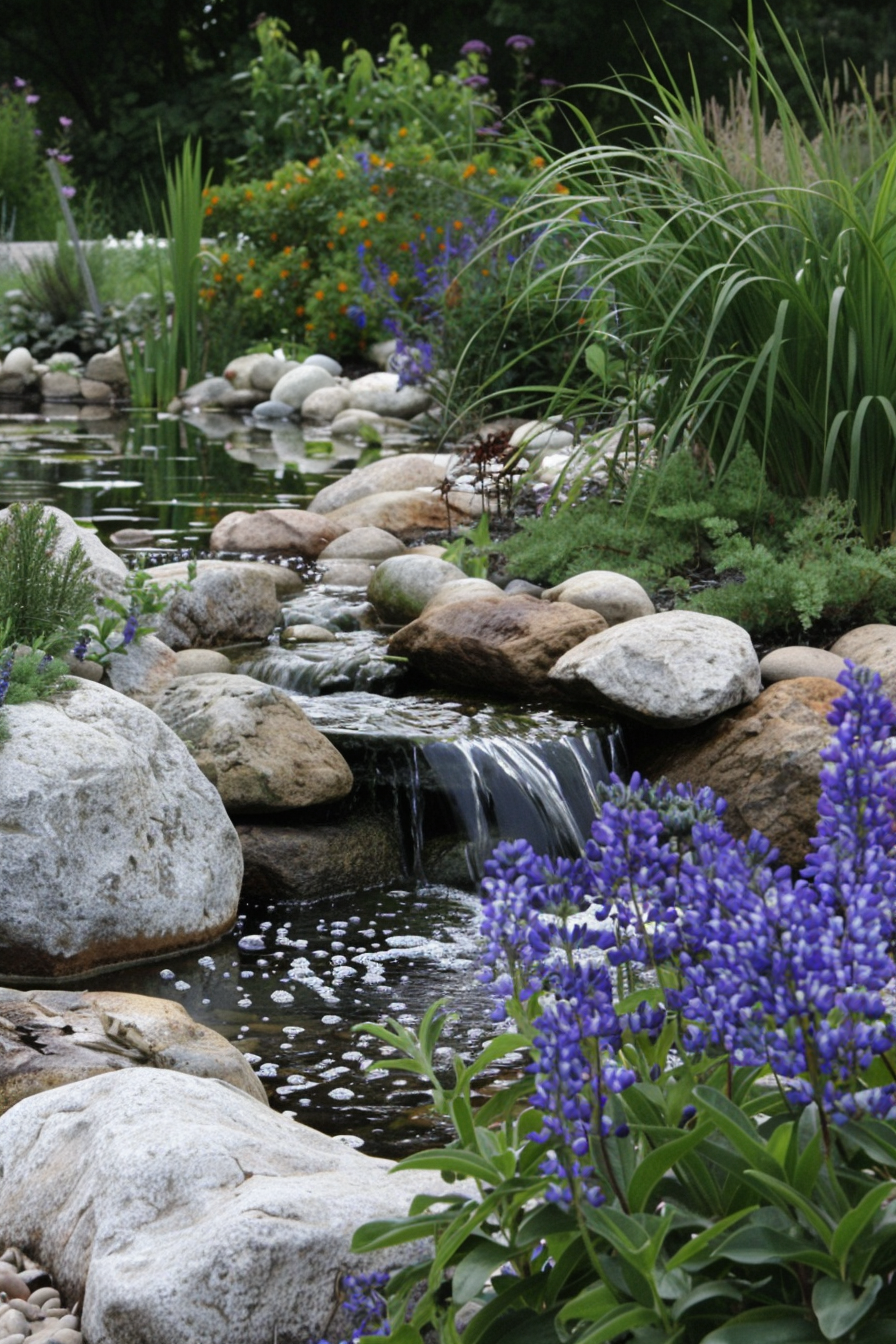
Integrate rocks with a small fountain, pond, or waterfall to add a tranquil element to your flower bed. The combination of water and stones creates a soothing garden retreat.
Flower Suggestions:
- Water Lily (Nymphaea spp.): Floating water lilies add a splash of color and elegance to water features.
- Bog Sage (Salvia uliginosa): With its tall spikes of blue flowers, bog sage thrives near water and complements rock elements.
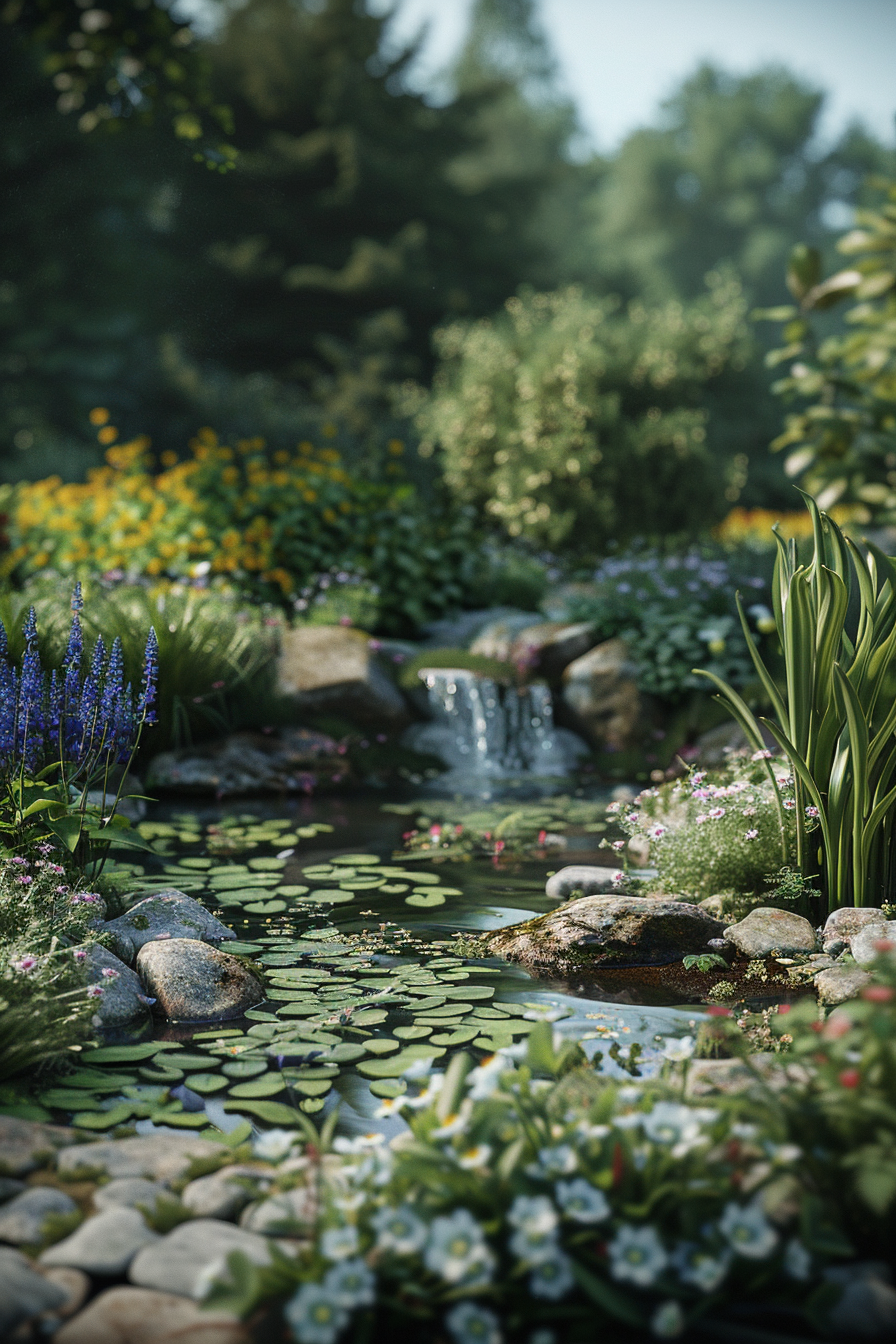
9. Use Rocks to Create Terraces
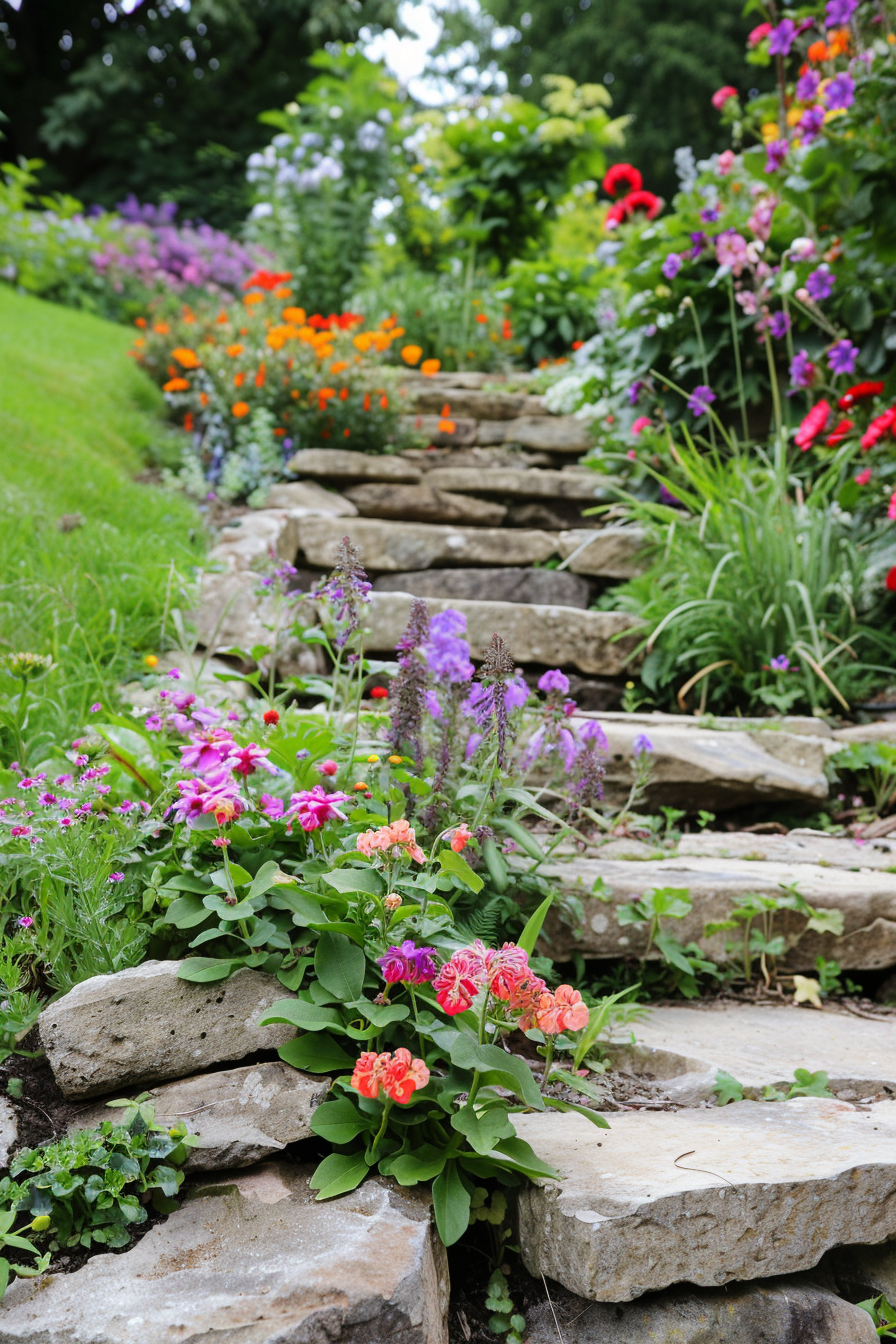
If you have a sloped garden, use rocks to build terraces. This not only controls erosion but also creates multiple planting levels, adding depth and interest to your flower bed.
Flower Suggestions:
- Creeping Jenny (Lysimachia nummularia): This trailing plant with yellow-green leaves cascades beautifully over terraced rocks.
- Geranium (Geranium spp.): With its mounding habit and colorful flowers, geranium is perfect for filling terraced levels.
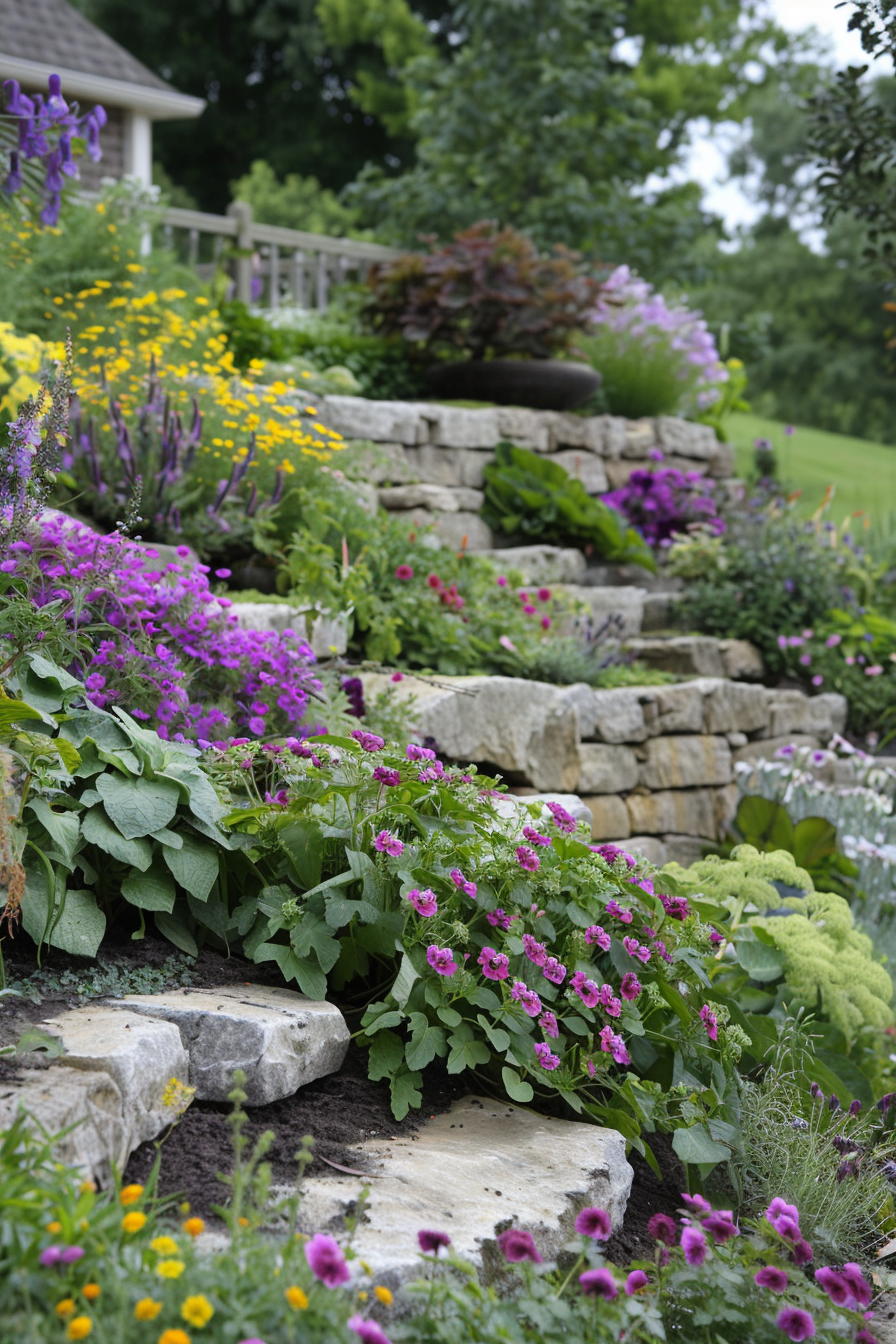
10. Embed Rocks in Garden Beds
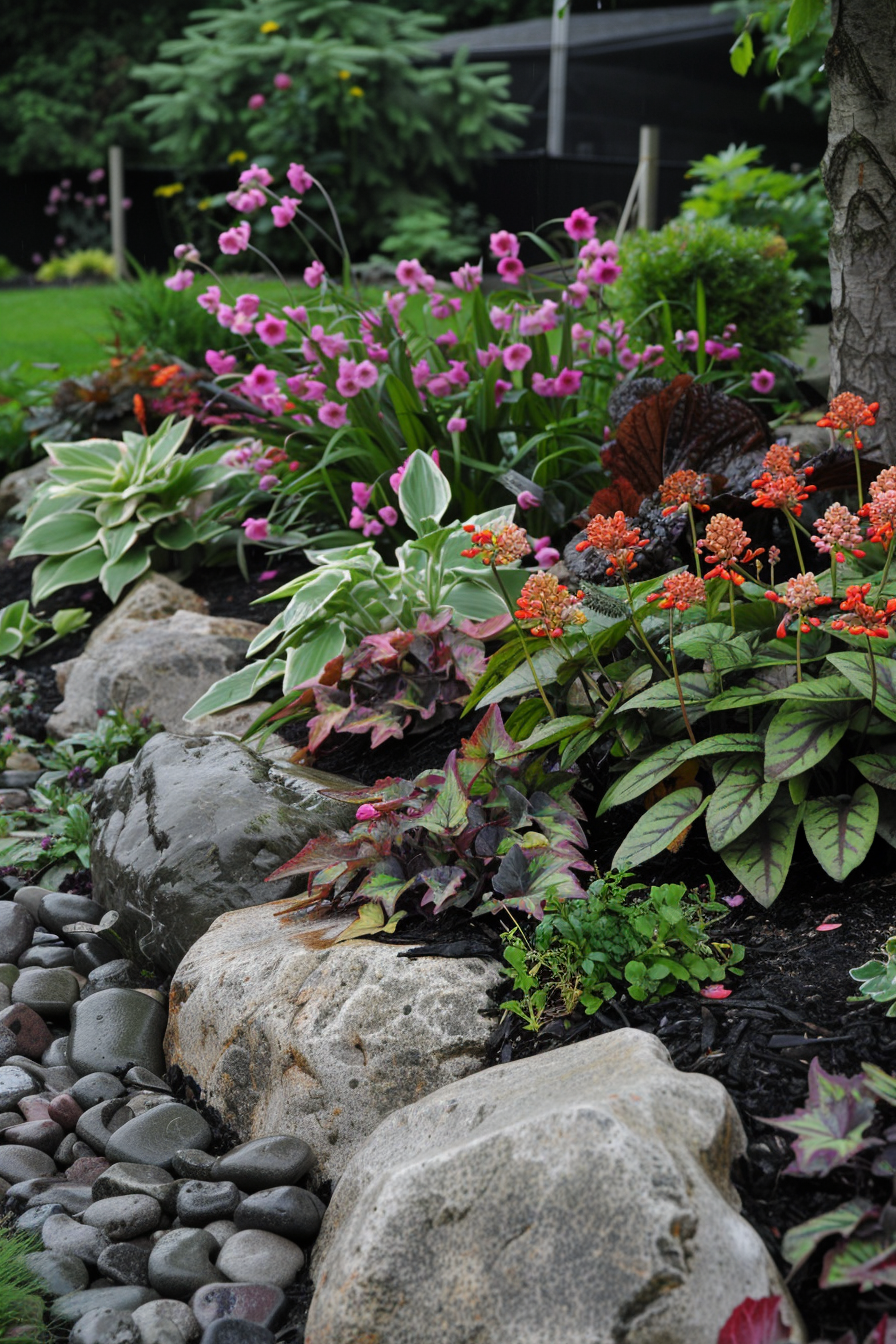
Embedding rocks directly into your flower beds can break up the monotony and add interest. Arrange them in a way that complements the natural flow of your plants.
Flower Suggestions:
- Hellebore (Helleborus spp.): The nodding flowers of hellebores look stunning against embedded rocks.
- Heuchera (Heuchera spp.): With its colorful foliage, heuchera adds vibrancy and texture among rocks.
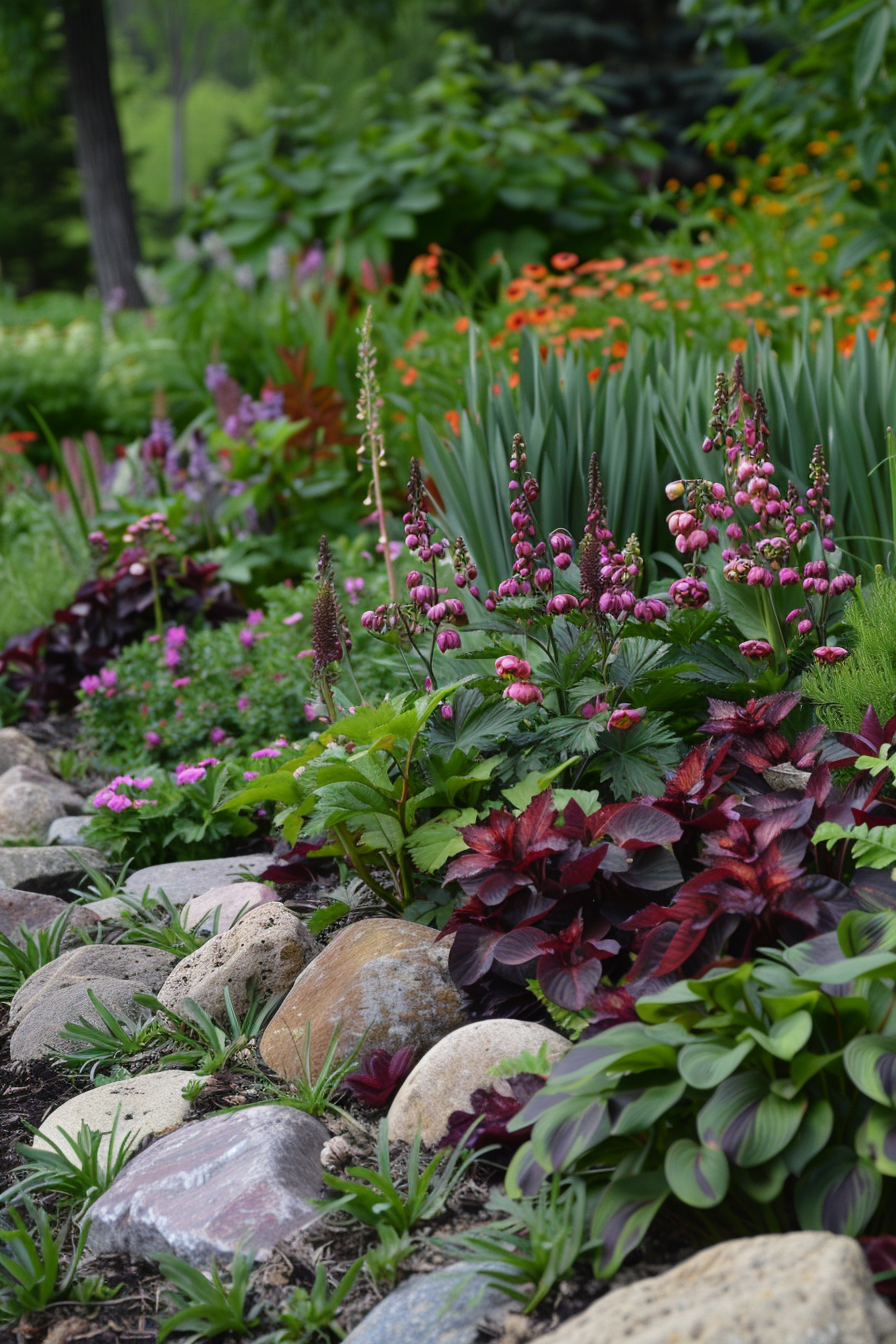
11. Create Rock Circles or Spirals
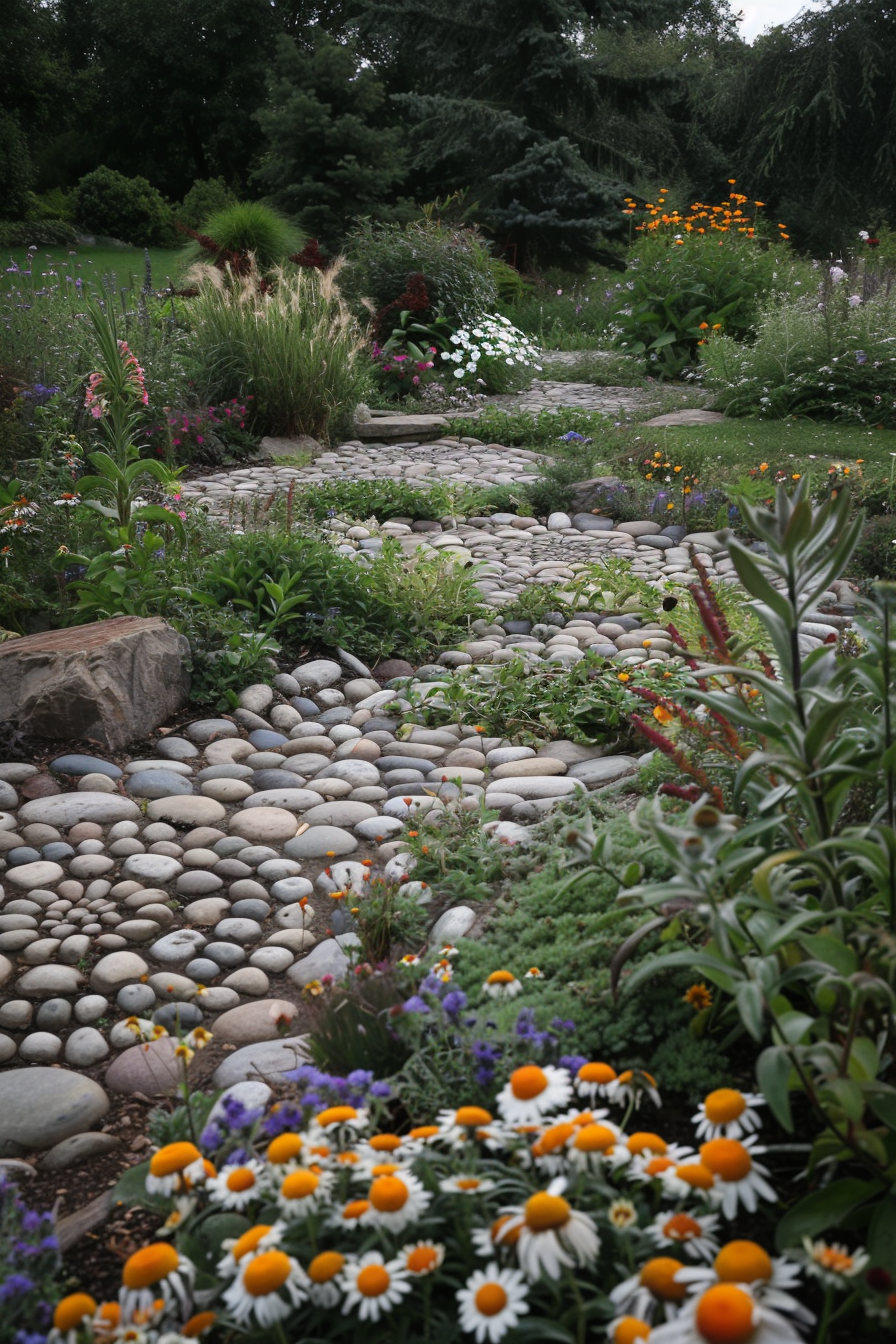
Design intricate patterns with rocks, such as circles or spirals, to add a decorative touch to your flower bed. These patterns can serve as a focal point and add visual intrigue.
Flower Suggestions:
- Rosemary (Rosmarinus officinalis): This herb’s upright growth and fragrant foliage complement geometric rock designs.
- Cosmos (Cosmos bipinnatus): With its airy, daisy-like flowers, cosmos adds a whimsical touch to structured rock patterns.
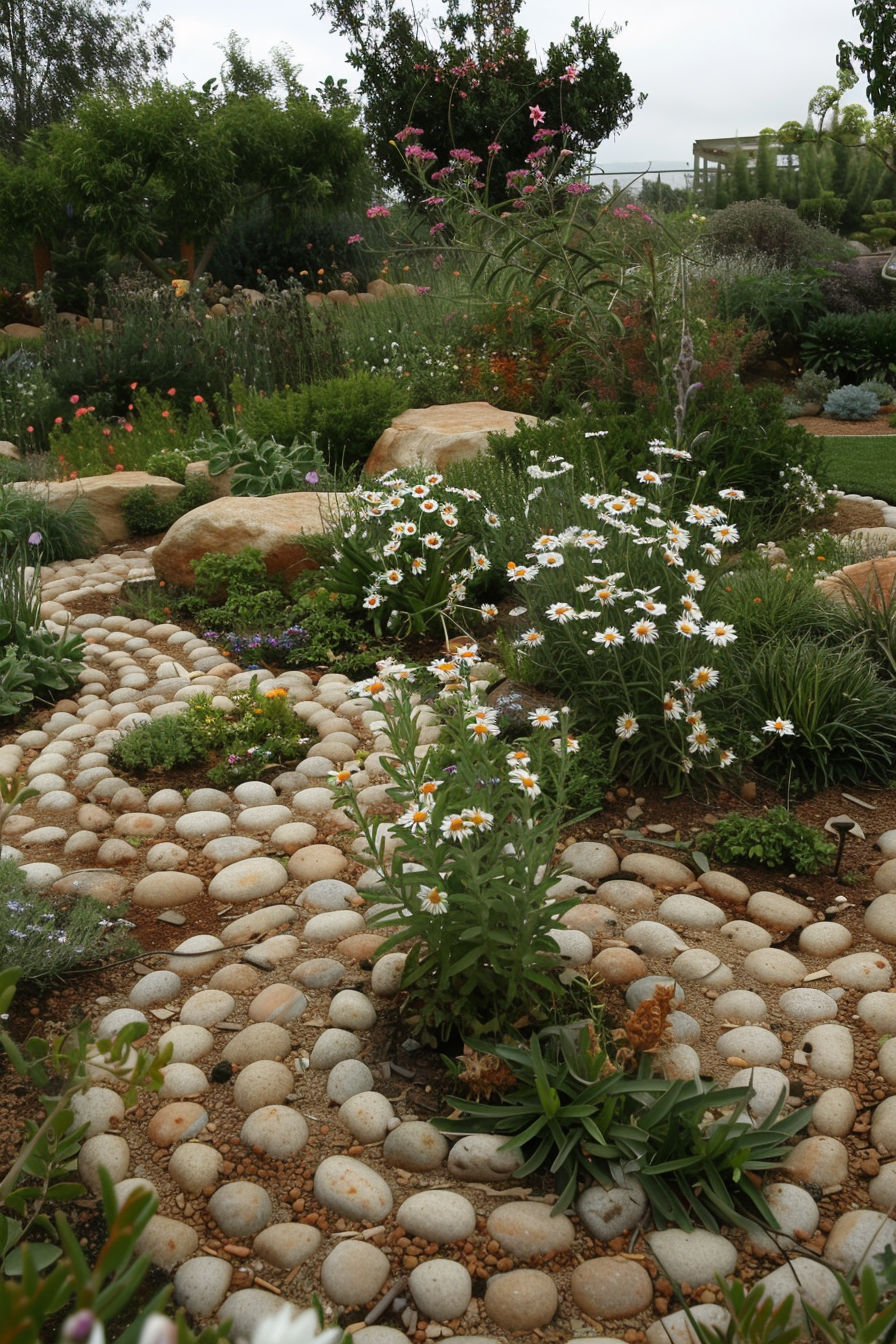
12. Use Pebbles for Ground Cover
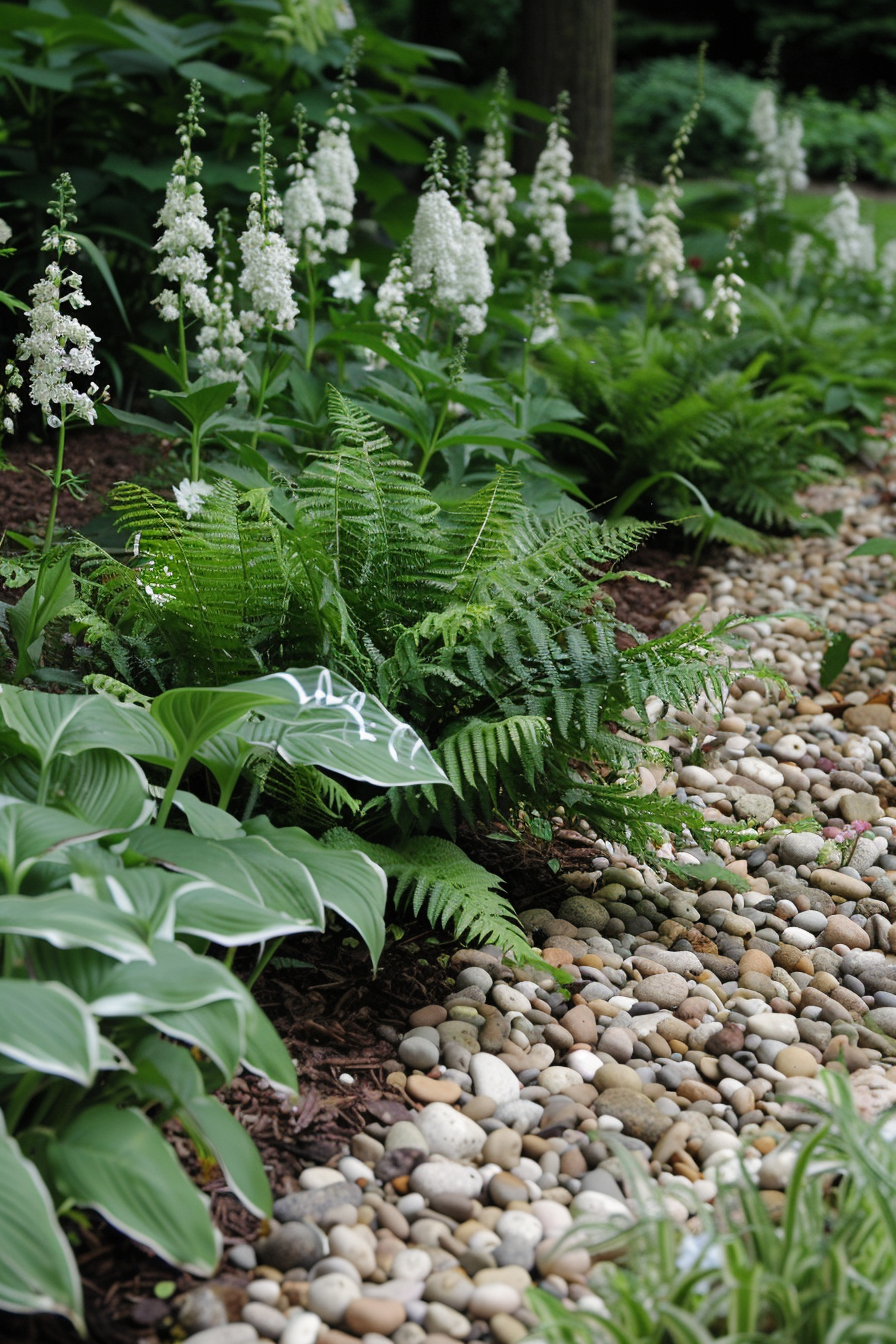
Cover the soil surface with small pebbles to create a tidy, finished look. Pebbles help retain moisture and prevent weeds, making them both functional and decorative.
Flower Suggestions:
- Ferns (Various species): Ferns thrive in the cool, moist environment created by pebble ground cover.
- Astilbe (Astilbe spp.): These feathery flowers add a delicate contrast against a bed of pebbles.
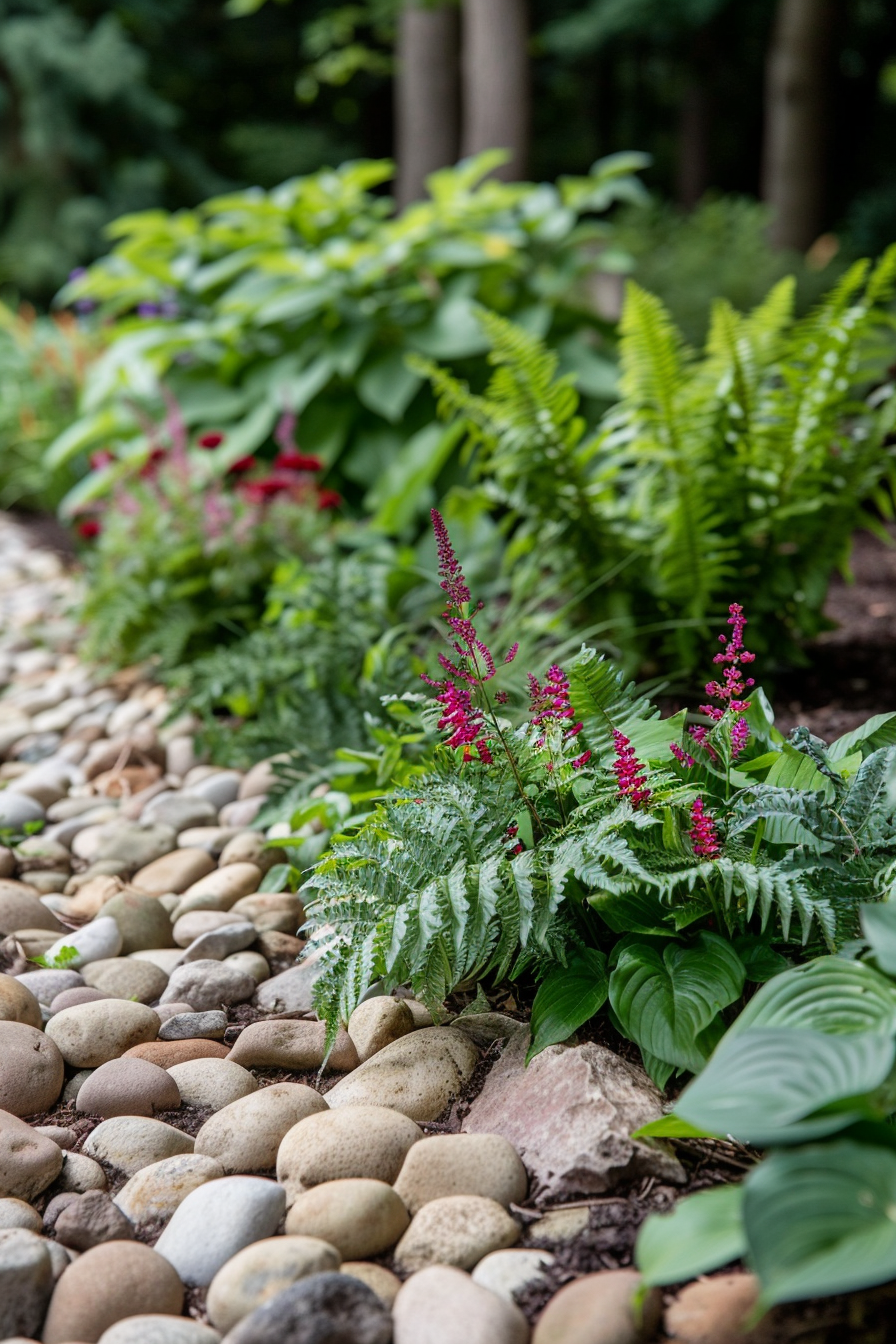
13. Highlight Succulents with Rocks
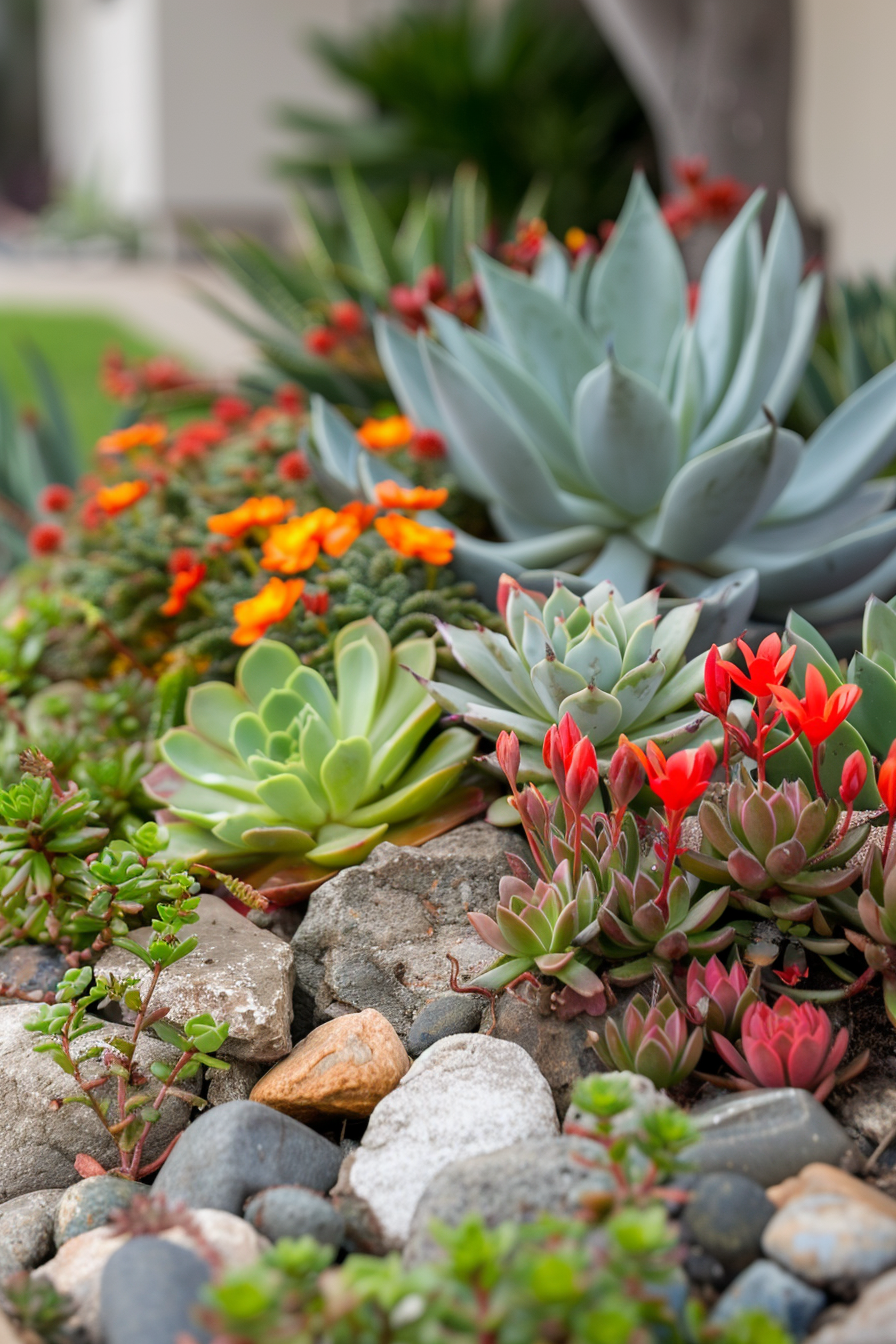
Succulents and rocks are a natural pairing, both thriving in well-drained conditions. Use rocks to create a minimalist, modern look that showcases the unique forms of succulents.
Flower Suggestions:
- Aloe (Aloe spp.): The bold, architectural shape of aloe pairs well with rocks in a succulent garden.
- Sedum (Sedum spp.): Various sedums add color and texture, complementing the clean lines of rocks.
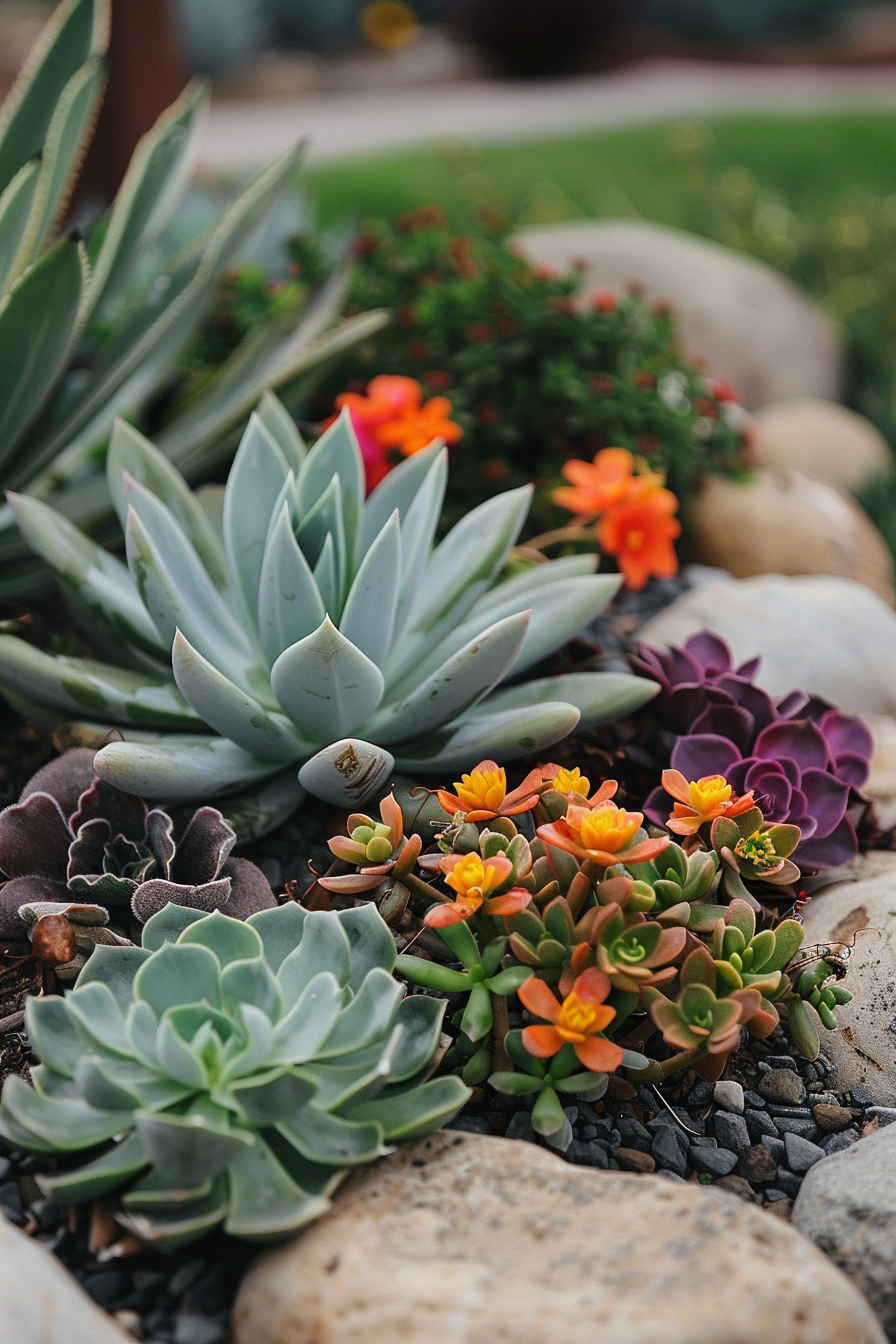
14. Combine Rocks with Ornamental Grasses
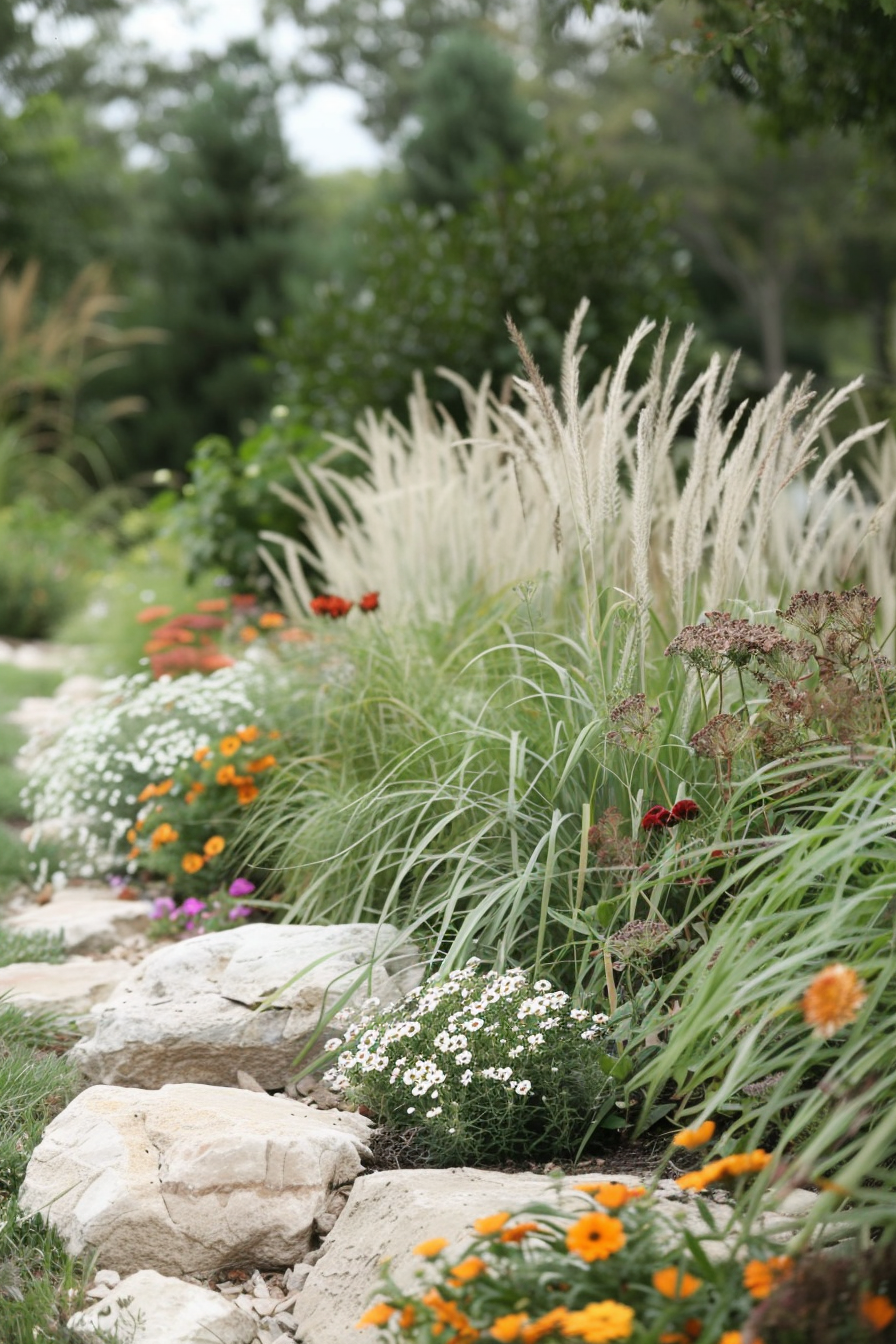
Ornamental grasses add movement and softness to the static nature of rocks. Plant grasses around rocks to create a dynamic and textural contrast in your flower bed.
Flower Suggestions:
- Feather Reed Grass (Calamagrostis acutiflora): This tall, elegant grass sways gently around rocks.
- Blue Oat Grass (Helictotrichon sempervirens): The blue-grey foliage of oat grass provides a striking contrast to rocks.
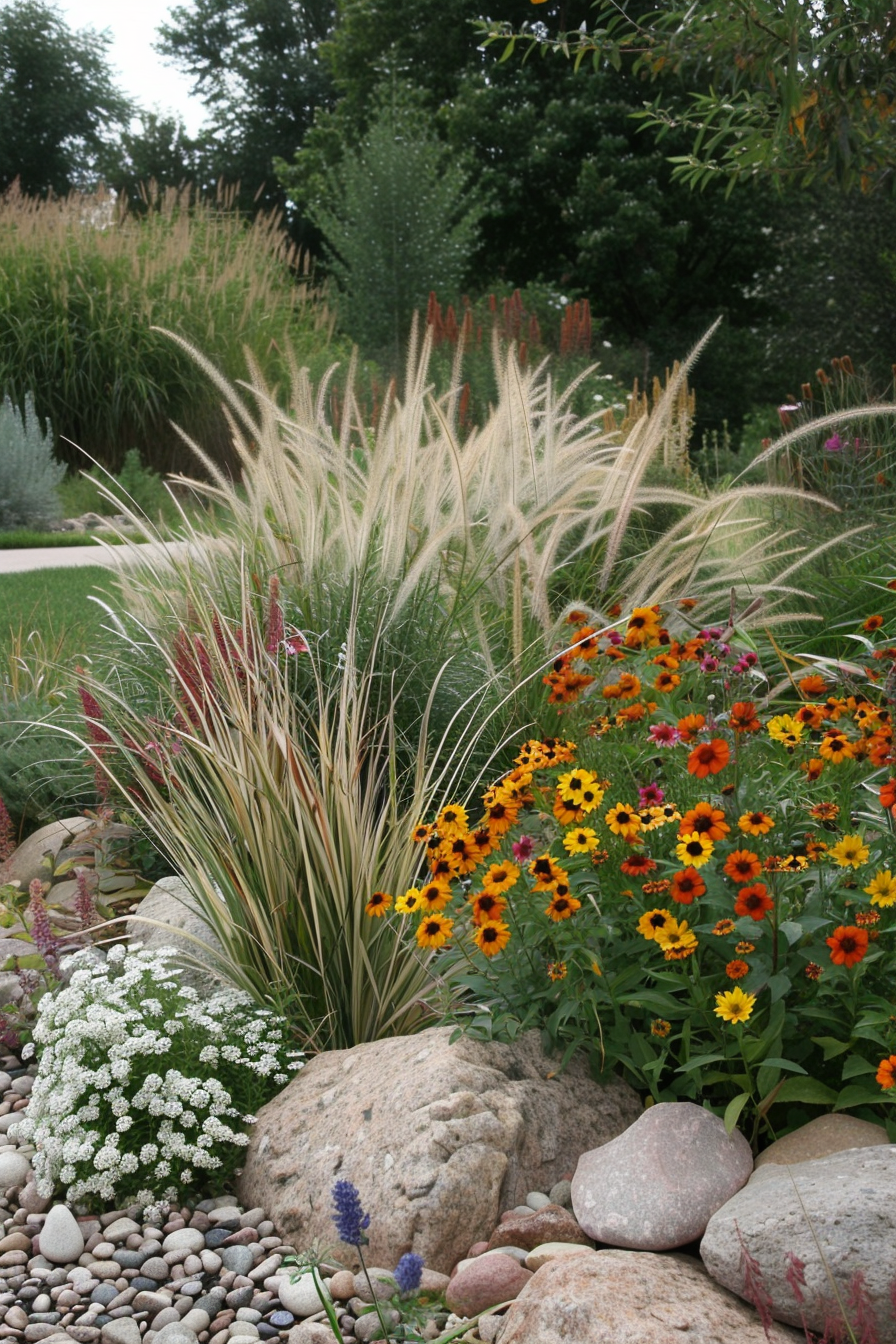
15. Use Rocks to Create Zen Spaces
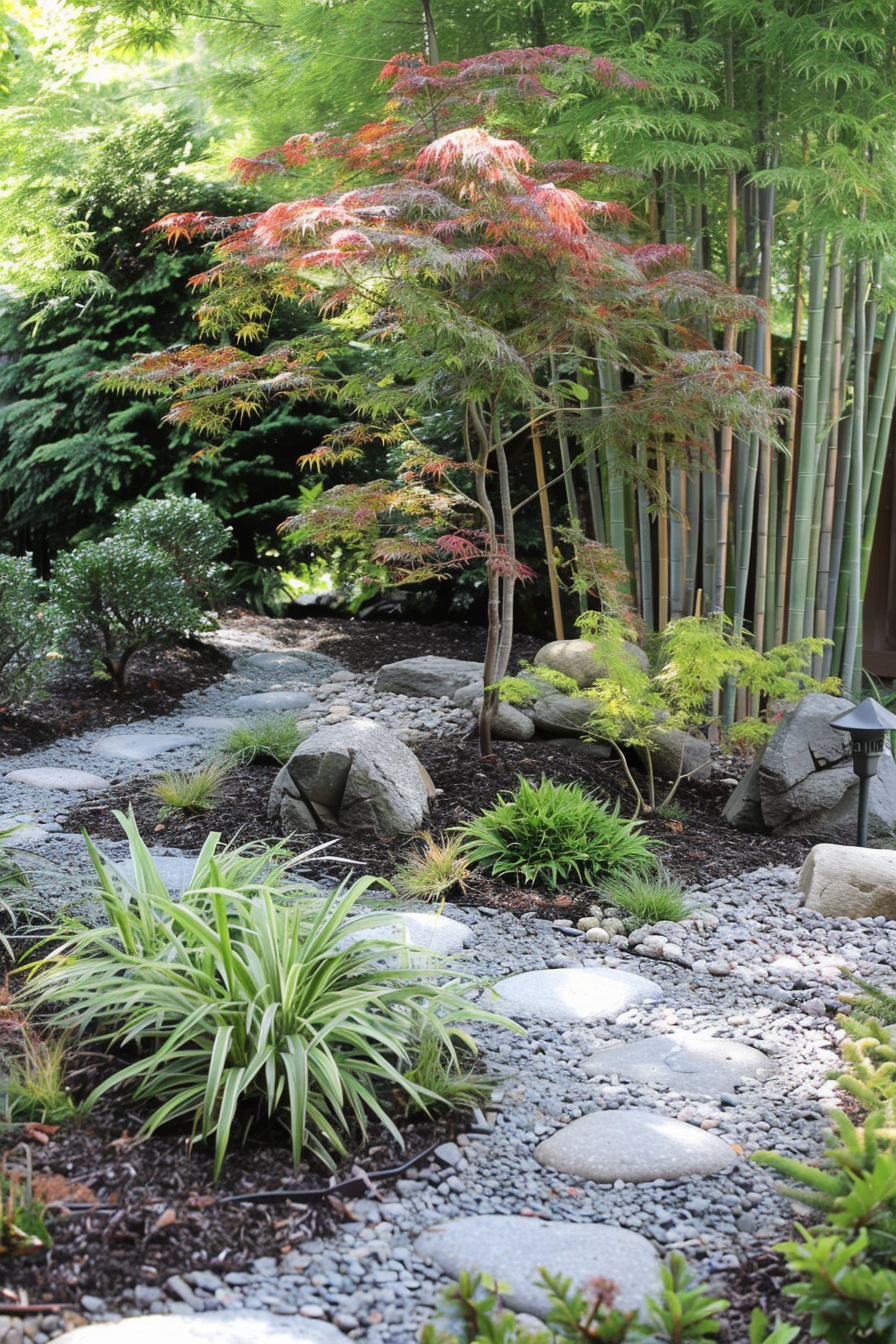
Incorporate rocks into a peaceful Zen garden within your flower bed. Arrange them to create a serene, meditative space that invites tranquility and reflection.
Flower Suggestions:
- Japanese Maple (Acer palmatum): With its delicate leaves and elegant form, the Japanese maple enhances the tranquility of a Zen space.
- Bamboo (Various species): Bamboo adds height and a calming rustle to a Zen garden, complementing the rocks.
